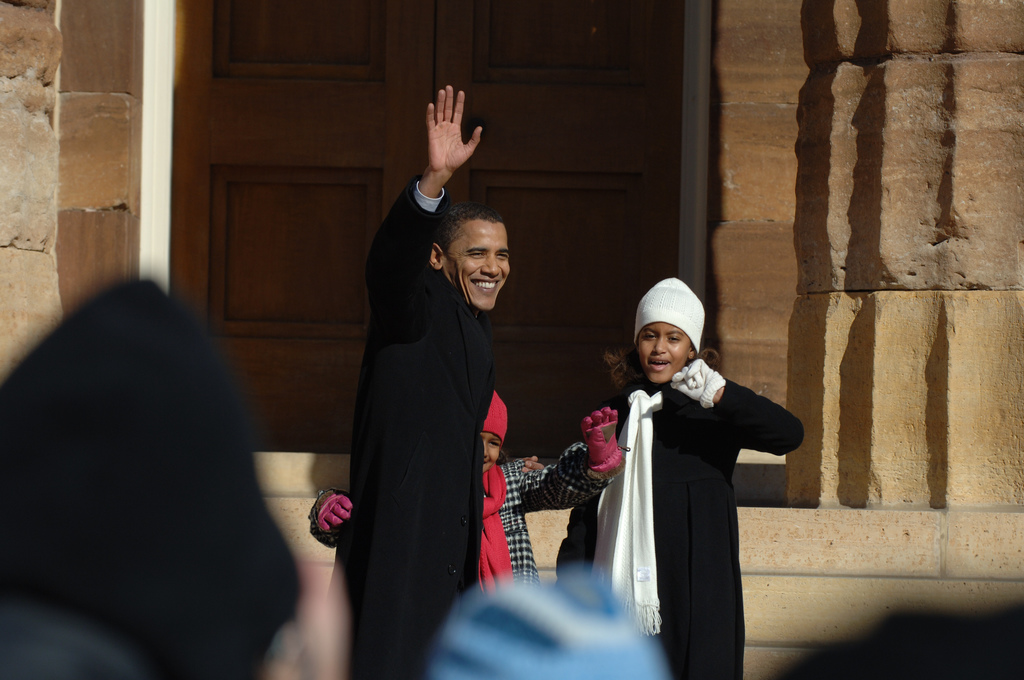2012-2017
Explore the highlights of the Obama’s second term in the White House.

January 1, 2012
The 2012 Campaign: Forward

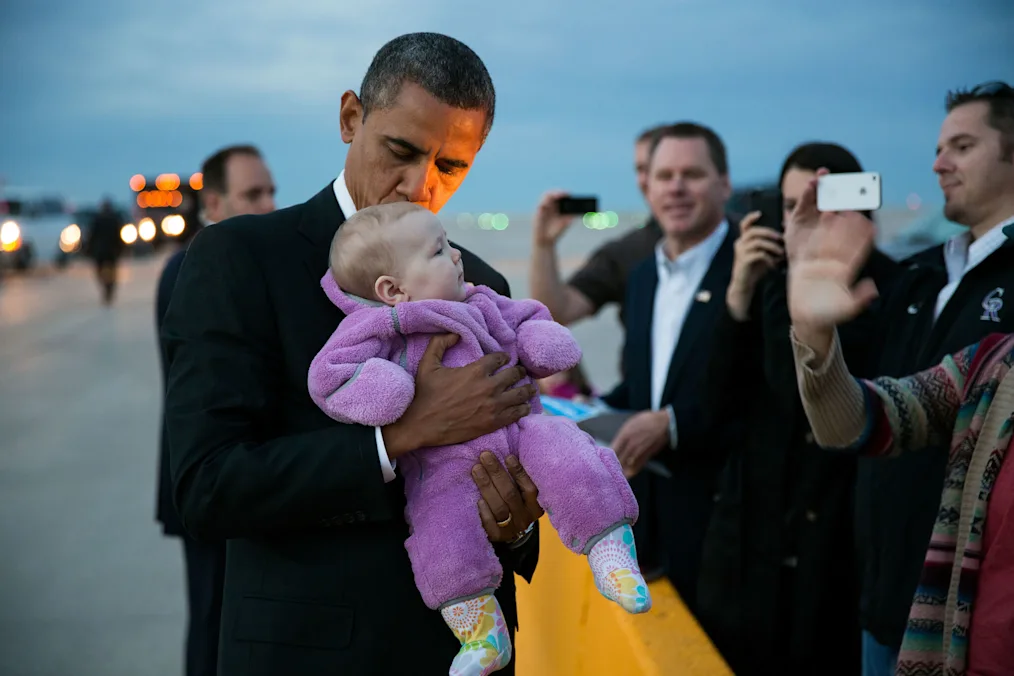
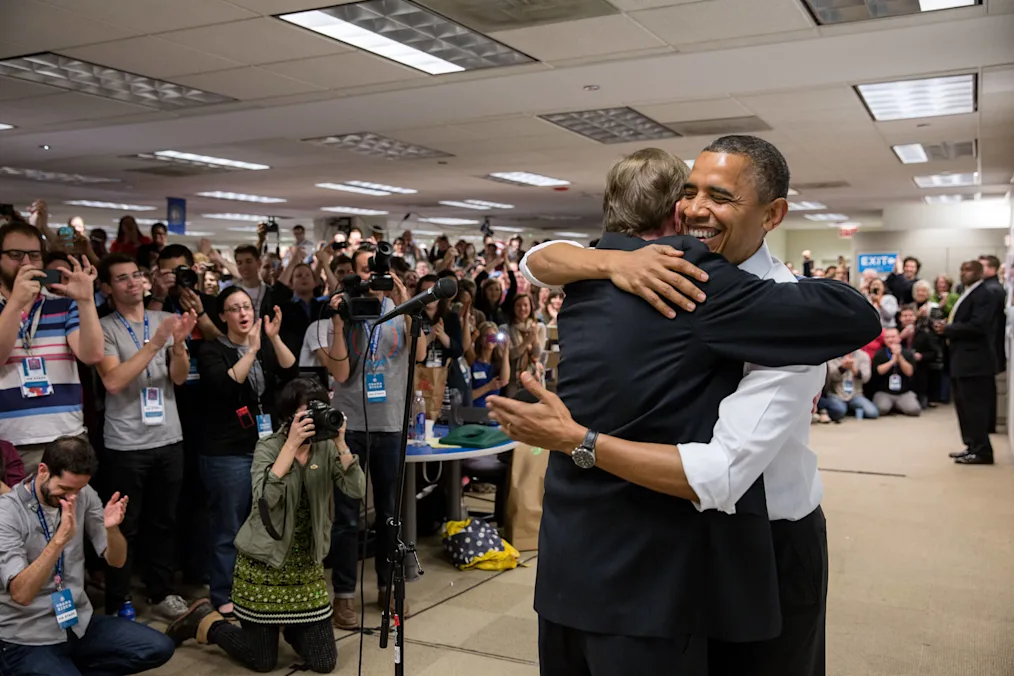

“ Tonight in the election, you the American people reminded us that while our road has been hard, while our journey has been long, we have picked ourselves up, we have fought our way back and we know in our hearts that for the United States of America the best is yet to come.”
–President Barack Obama, November 2012
May 11, 2012
Helped Responsible Homeowners Stay in Their Homes
President Obama made it easier for responsible homeowners to stay in their homes — avoiding foreclosures that would have hurt them and the economy and helping underwater homeowners refinance. In all, more than 10 million mortgage modification and other forms of mortgage assistance were completed to help mitigate the foreclosure crisis.

May 23, 2012
Established the Presidential Innovation Fellows
The Presidential Innovation Fellows (PIF) program brings the principles, values, and practices of the innovation economy into government through the most effective agents of change we know: our people. This highly-competitive program pairs talented, diverse technologists and innovators with top civil-servants and change-makers working at the highest levels of the federal government to tackle some our nation’s biggest challenges. These teams of government experts and private-sector doers take a user-centric approach to issues at the intersection of people, processes, products, and policy to achieve lasting impact.
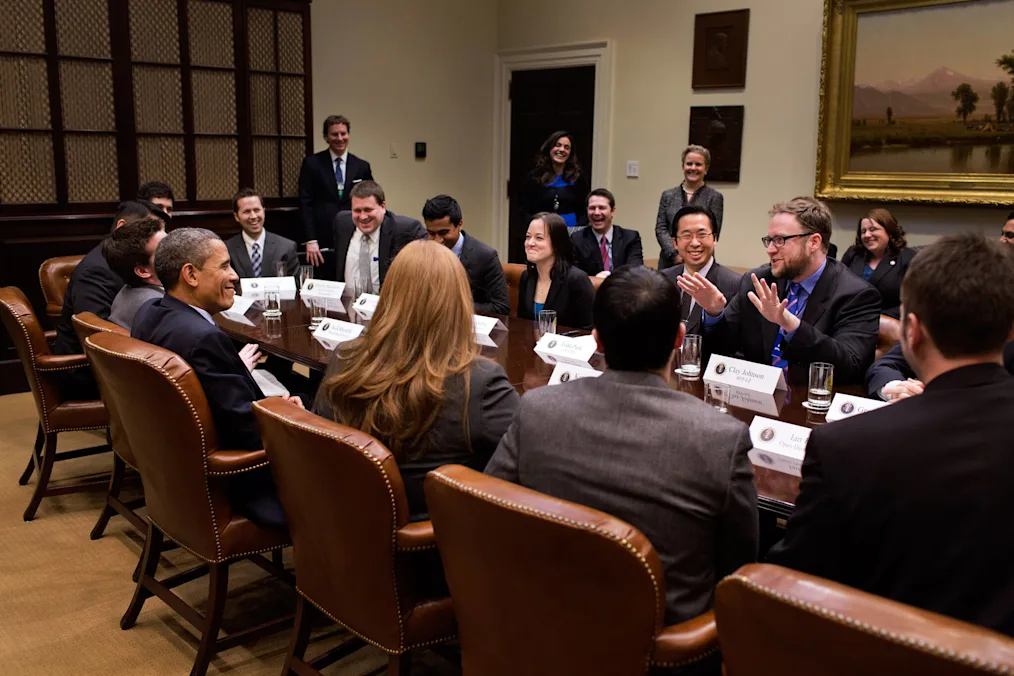
On August 17, 2015 President Obama made the Presidential Innovation Fellows program permanent. He noted that to-date fellows have helped,
Veterans access care and benefits more easily,
Families have greater access to their electronic medical records,
Police departments make their data searchable online, and
Students gain access to high speed internet in school.
“ We must harness new ideas and technology to remake our government…”
–President Barack Obama, January 2013
Restored the Gulf Coast Ecosystem
On April 20, 2010, the blowout and explosion of the mobile offshore drilling unit Deepwater Horizon resulted in the largest oil spill in U.S. history (Deepwater Horizon Oil Spill).
In response, President Obama issued an Executive Order recognizing the Gulf Coast as a national treasure and addressing the longstanding ecological decline of that region, which was compounded by the Deepwater Horizon Oil Spill.
The Executive Order established a Gulf Coast Ecosystem Restoration Task Force (Task Force) to coordinate intergovernmental efforts, planning, and the exchange of information in order to better implement Gulf Coast ecosystem restoration and facilitate appropriate accountability and support throughout the restoration process.
Two years later, building upon the Task Force’s successful collaboration between between Federal, State, and tribal governments, the Administration established the Gulf Restoration Council through the RESTORE Act, bringing five states and six Federal agencies together to restore Gulf Coast ecosystems and communities.
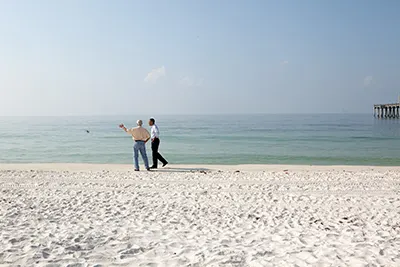
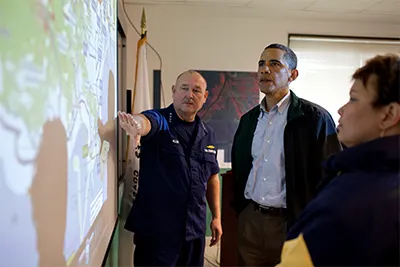
January 2, 2013
Made the Tax System Fairer
The Obama Administration made permanent tax cuts for 98 percent of Americans as part of the bipartisan fiscal cliff agreement in January 2013, while allowing costly tax cuts to expire for those with the highest incomes — which will reduce deficits by more than $800 billion over the next ten years.
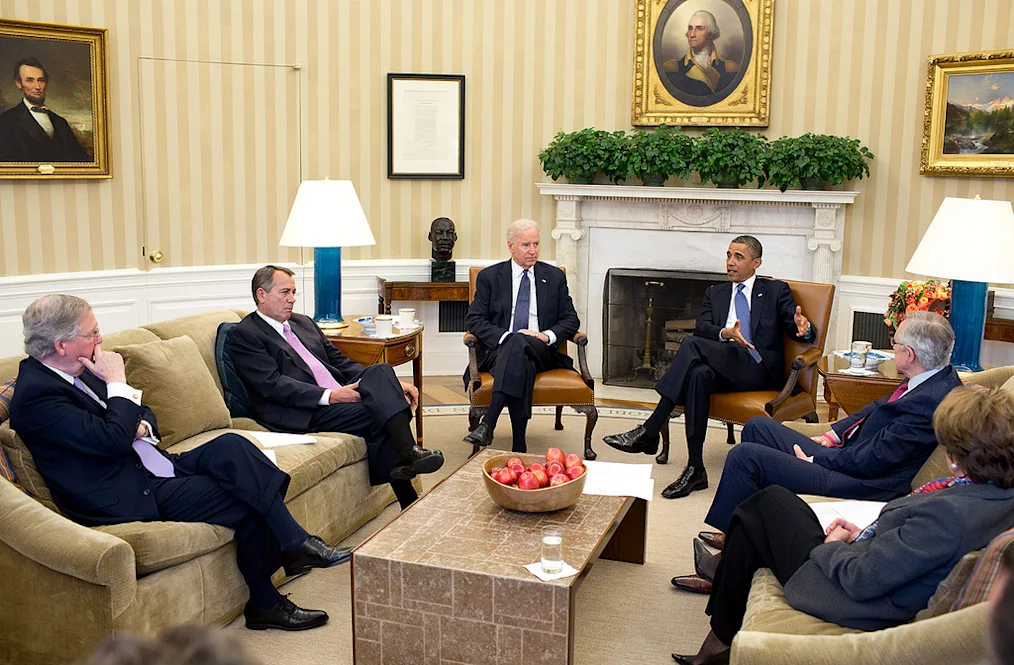
February 3, 2013
Made Buildings More Efficient
President Obama established the Better Buildings Challenge to enlist cities, states, utilities, manufacturers, school districts, and businesses to improve energy efficiency, targeting heavy users such as data centers and outdoor lighting systems. He worked with companies, mayors, university presidents, and labor leaders to drive $4 billion of investment in energy-efficiency upgrades for public and private buildings.
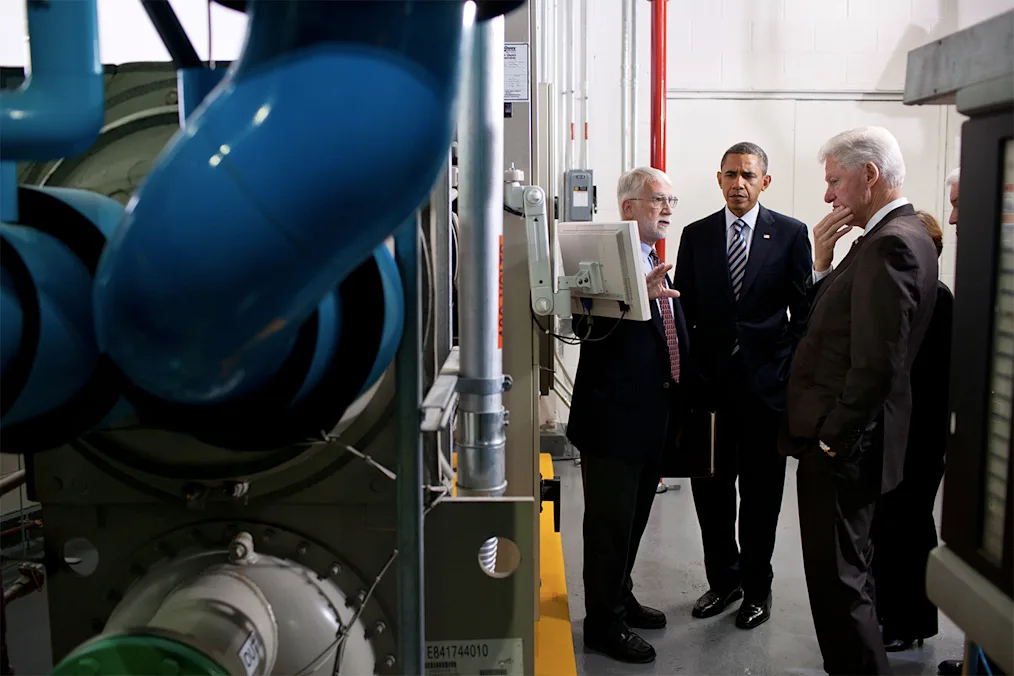
February 12, 2013
Improved America’s Cybersecurity
On February 12, 2013, President Obama signed Executive Order 13636, “Improving Critical Infrastructure Cybersecurity.” The Executive Order was designed to increase the level of core capabilities for our critical infrastructure to manage cyber risk. It did this by focusing on three key areas: (1) information sharing, (2) privacy, and (3) the adoption of cybersecurity practices.
The EO tasked the National Institute for Standards and Technology (NIST) to work with the private sector to identify existing voluntary consensus standards and industry best practices and build them into a Cybersecurity Framework. The Administration recognized that there were private-sector cyber leaders who were already implementing strong cybersecurity controls, policies, procedures and innovations and asked these companies to help us shape best practices across critical infrastructure.
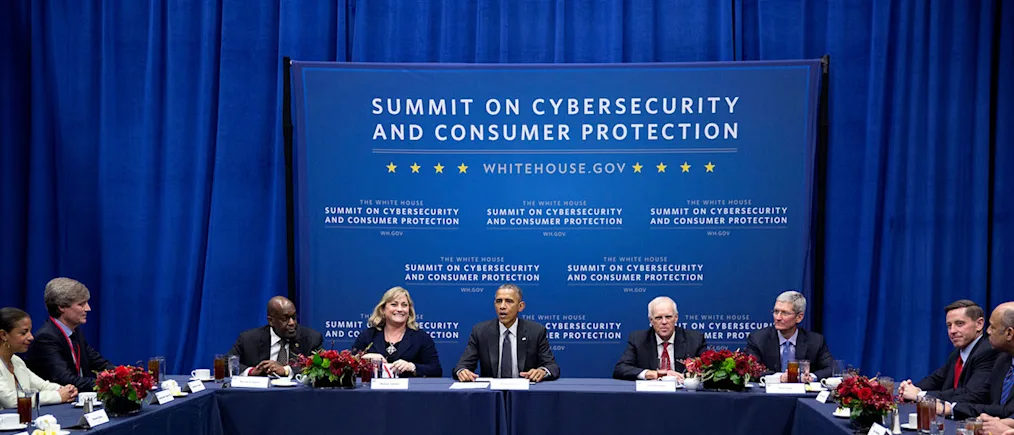
Modernized Medical Records
Until the President made investments in health information technology by signing the American Recovery and Reinvestment Act, our health care system ran largely on paper. Now, more than 75 percent of doctors now use electronic health records thanks to Administration policies.
June 25, 2013
Removed Carbon Pollution from the Air
President Obama took a series of common-sense steps to curb carbon pollution and other greenhouse gases through initiatives that drove energy efficiency, promoted clean energy, and put in place the first-ever carbon pollution standards for power plants.
In 2012, U.S. carbon pollution from the energy sector fell to the lowest level in two decades even as the economy continued to grow. To build on this progress, the Obama Administration put in place tough new rules to cut carbon pollution — just like we have for other toxins like mercury and arsenic.
The plan also set a goal to reduce carbon pollution by at least three billion metric tons cumulatively by 2030 — more than half of the annual carbon pollution from the U.S. energy sector — through efficiency standards set over the course of the Administration for appliances and federal buildings.

Helped Insure Millions of Young Adults
2.3 million additional young adults (aged 19-25) gained health insurance coverage between the enactment of the Affordable Care Act in 2010 and the start of open enrollment in October 2013 due to the ACA provision allowing young adults to remain on a parent’s plan until age 26.
Read: Health Insurance Coverage and The Affordable Care Act, 2010–2016 (Opens in a new tab)
Reformed Wall Street
The Obama Administration established the Consumer Financial Protection Bureau (CFPB) to hold financial institutions accountable and protect consumers from the types of abuses that preceded the crisis. Since its creation, this new independent watchdog has established safer national mortgage standards to better determine a borrower’s ability to repay over the long term, launched new transparency requirements that clearly spell out interest rates and payments, and subjected credit reporting agencies, debt collection agencies, and payday lenders to federal supervision for the first time.
The Administration also adopted the Volcker Rule to prohibit banks from risky proprietary trading and from sponsoring investment funds that are unrelated to core banking activities.
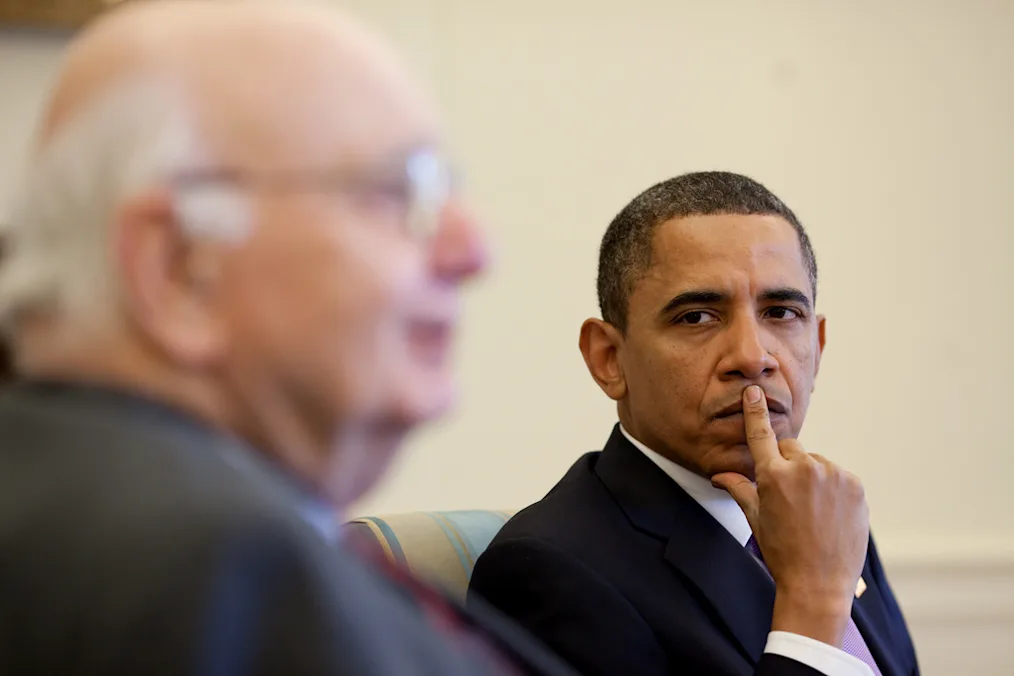
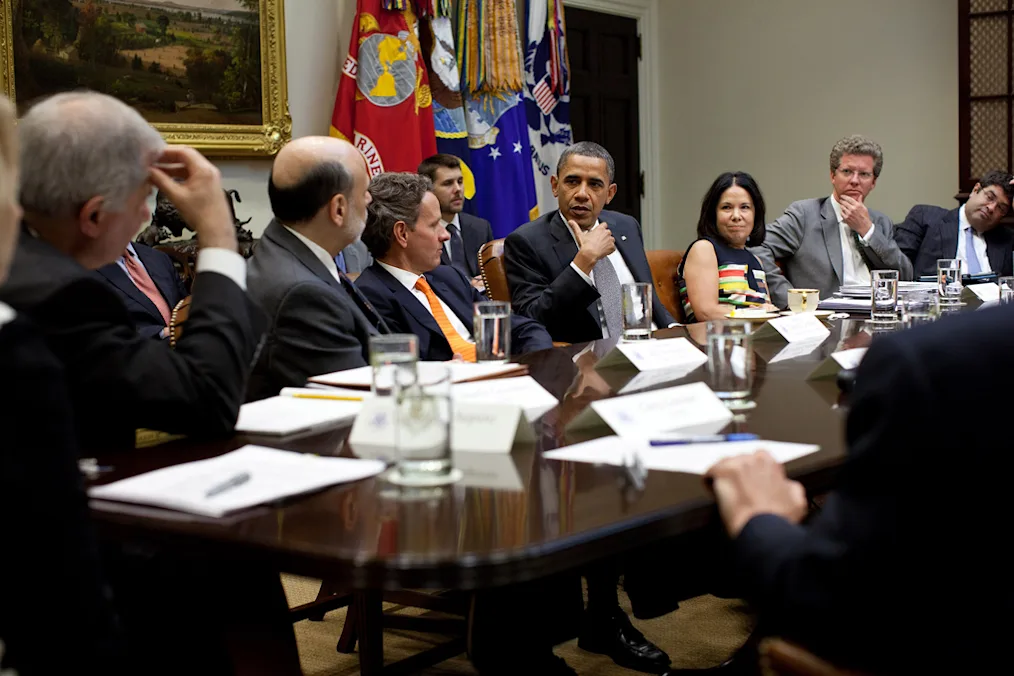
February 27, 2014
Launched “My Brother’s Keeper”
On February 27, 2014, the President launched “My Brother’s Keeper” (MBK) and issued a powerful call to action to close opportunity gaps still faced by too many young people, and often by boys and young men of color in particular. The President’s announcement encouraged candid dialogues around the country and a greater sense of responsibility among community leaders, and young people themselves to put all youth in a position to thrive, regardless of their race, gender, or socioeconomic status.
More than $500 million in non-federal grants and in-kind resources and $1 billion in independently committed financing have aligned with objectives of the MBK initiative.

The My Brother's Keeper Initiative
“ That’s what ‘My Brother’s Keeper’ is all about. Helping more of our young people stay on track. Providing the support they need to think more broadly about their future. Building on what works – when it works, in those critical life-changing moments.”
–President Barack Obama, February 27, 2014

Led a Global Effort Against Nuclear Proliferation
The Obama Administration secured a landmark multilateral deal to roll back the Iranian nuclear program and verify that Iran cannot obtain a nuclear weapon. Nuclear physicists, military officials, non-proliferation experts, and more than 100 countries across the globe all voiced their support for the Iran nuclear deal because it was the best solution available to prevent Iran from obtaining a nuclear weapon without taking military action.
The Administration also led global efforts to secure nuclear materials to prevent them from falling into the hands of terrorists through four Nuclear Security Summits.
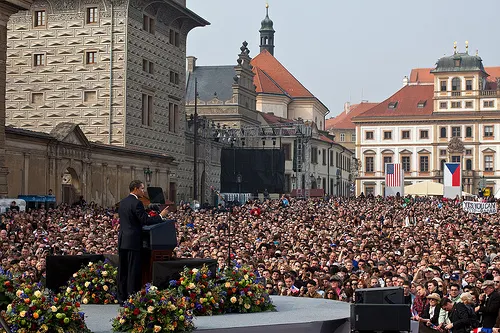
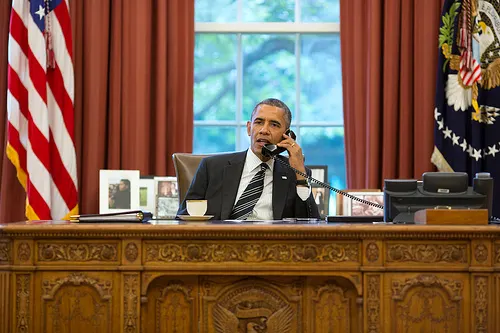
Fought for Fair Pay for All Genders
President Obama signed the Lilly Ledbetter Fair Pay Act, empowering workers to recover wages lost to discrimination by extending the time period for parties to bring pay discrimination claims, and took other steps helping to shrink the gender pay gap by more than 10 percent.
Additionally, he signed an April 2014 Executive Order that prohibits federal contractors from discriminating against employees who choose to discuss their compensation, further strengthening equal pay laws.

The Right to Equal Pay for Equal Work

August 11, 2014
A Startup in the White House: The United States Digital Service
Formally launched by the Administration on August 11, 2014, the U.S. Digital Service is a small team of our country’s brightest digital talent that will work with government agencies to find more effective ways to use technology to improve the service, information, and benefits they provide.
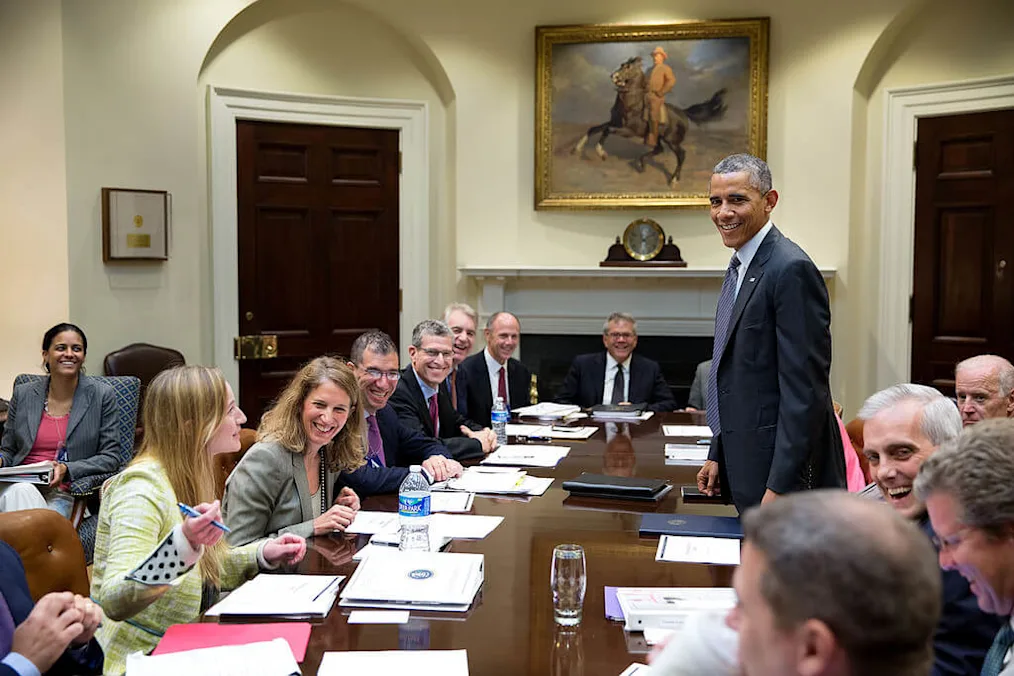

The United States Digital Service
“ …what we realized was that we could potentially build a SWAT team, a world-class technology office inside of the government that was helping agencies. We’ve dubbed that the U.S. Digital Service…they are making an enormous difference…”
–President Barack Obama, March 2016
October 22, 2014
Fostered Climate Literacy
President Obama believed climate education and literacy are particularly important for building a 21st-century workforce, where tomorrow’s community leaders, city planners, and entrepreneurs have the information, knowledge, and training to make sound decisions and grow businesses in the context of a changing climate.
He launched the Climate Education and Literacy Initiative to ensure that all students and citizens have the knowledge and training they need to address the climate change challenge. The Initiative ensured that citizens of all ages have a solid grounding in science, technology, engineering, and math (STEM) skills that serve as a basis for discovery, invention, and innovation.
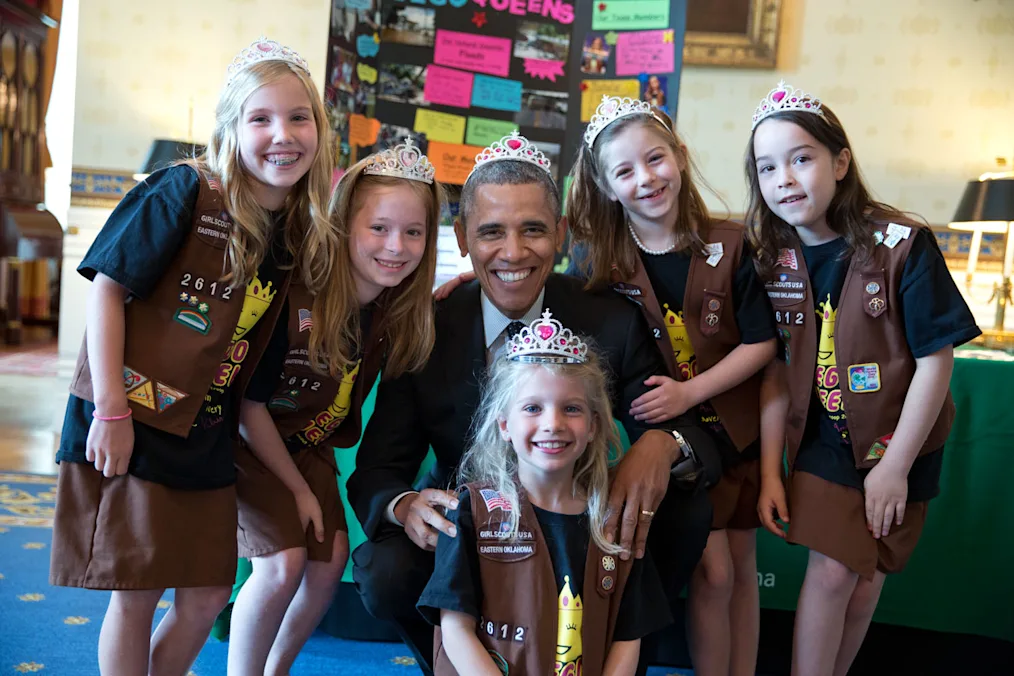
November 25, 2014
Reformed Our Immigration System
On November 21, 2014, the President established the White House Task Force on New Americans—a government-wide effort tasked with better integrating immigrants and refugees into American communities.
In June of 2012 the President implemented the Deferred Action for Childhood Arrivals (DACA) policy for young undocumented people who came to the U.S. as children in an effort to better focus enforcement resources. Since its establishment, the Department of Homeland Security has approved close to 740,000 DACA requests on a case-by-case basis. More than 526,000 individuals have also successfully renewed DACA.

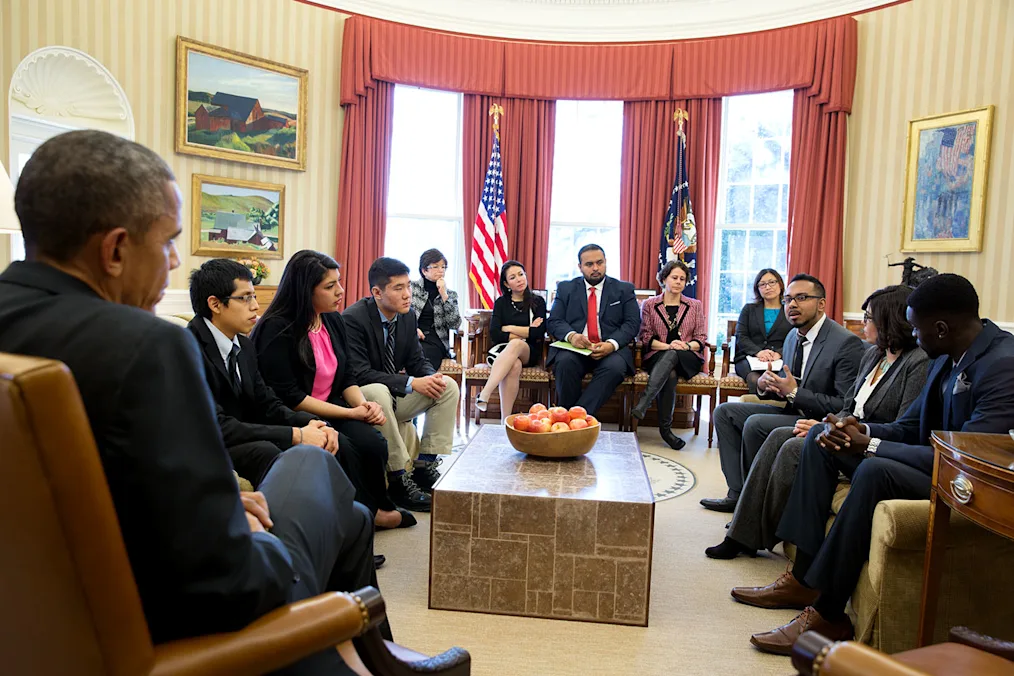
December 17, 2014
Normalized Relations with Cuba
On December 17, 2014, President Obama announced that he was rejecting the Cold War-era policy era of the past. He built a historic opening to Cuba, ending a failed policy of over 50 years by re-establishing diplomatic relations and facilitating greater travel, commerce, and people-to-people ties.
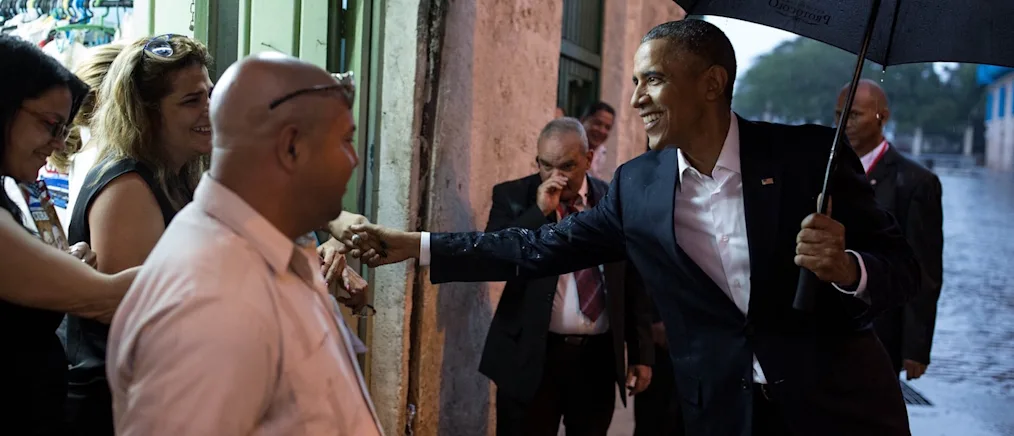

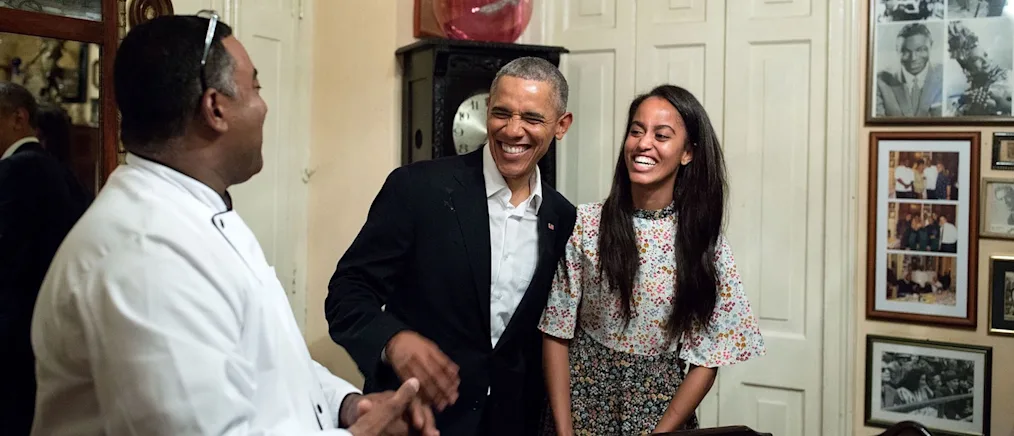
Unleashing the Power of Data to Increase Community Trust in Policing
Recent events in Ferguson, Missouri and around the country have grabbed the attention of the nation and the world, and have highlighted the importance of strong, collaborative relationships between local police and the communities that they protect.
On December 1, 2014, the Administration announced new steps they took to strengthen the relationships between law enforcement agencies and the communities they are obligated to protect and serve, including:
Advancing the use of body worn cameras and promoting proven community policing initiatives
Creating a new task force to promote expansion of the community-oriented policing model, which encourages strong relationships between law enforcement and the communities that they serve as a proven method of fighting crime
Reforming how the federal government equips state and local law enforcement – particularly with military-style equipment
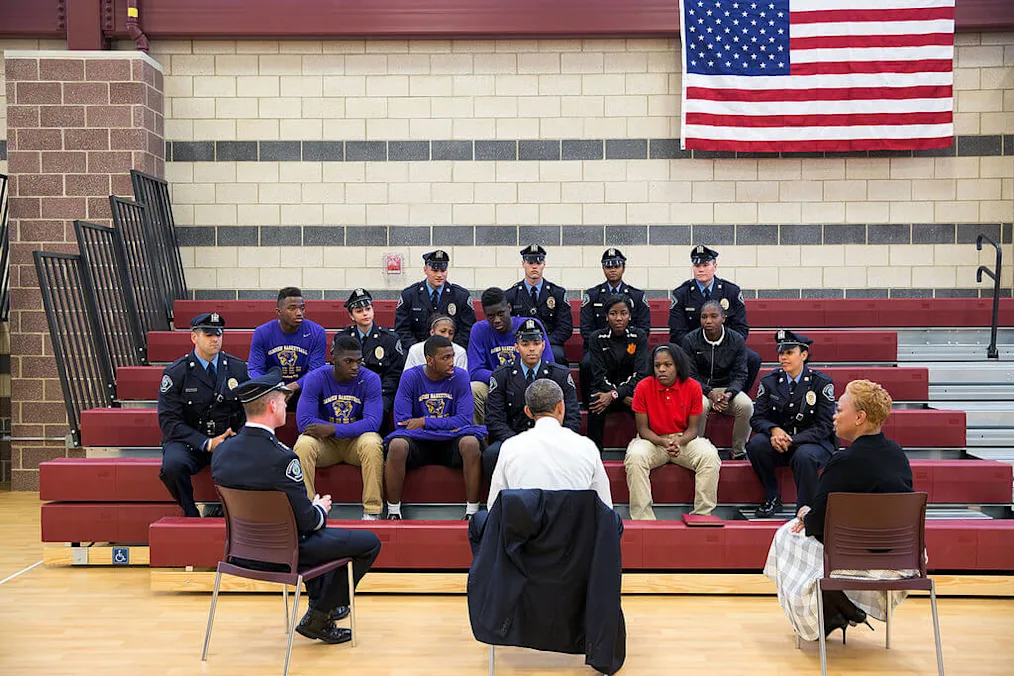
December 19, 2014
Expanded Opportunities for Those with Disabilities
On December 19, 2014, President Obama signed into law the Achieving a Better Life Experience Act, which allows individuals with disabilities receiving benefits to earn assets without risk of losing needed health benefits and income assistance
On February 10, 2015, Vice President Biden hosted an event at the White House with Members of Congress to highlight the benefits and achievements of the Achieving a Better Life Experience (ABLE) Act. The Act creates a new savings account for families with people with disabilities.

Vice President Biden Hosts an Event to Highlight the ABLE Act
January 9, 2015
Launched a New Manufacturing Network
The Obama Administration launched Manufacturing USA, which invests in U.S. leadership in emerging manufacturing technologies critical to our future competitiveness. Each manufacturing hub is designed to build U.S. leadership and regional excellence in critical emerging manufacturing technologies by bridging the gap between early research and product development; bringing together companies, universities, and other academic and training institutions, and federal agencies to co-invest in key technology areas that can encourage investment and production in the United States; and serving as a ‘teaching factory’ for workers, small businesses, and entrepreneurs looking to develop new skills or prototype new products and processes.
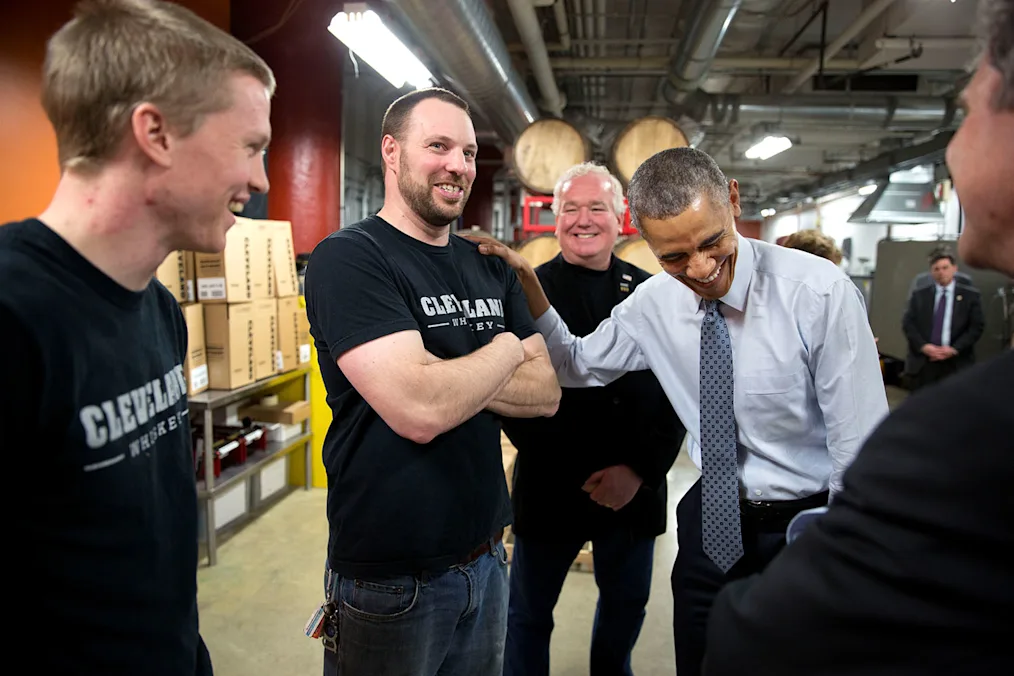
January 20, 2015
Launched the Precision Medicine Initiative: Data-Driven Treatments as Unique as Your Own Body
In his 2015 State of the Union address, President Obama announced that he’s launching the Precision Medicine Initiative — a bold new research effort to revolutionize how we improve health and treat disease.
Until now, most medical treatments have been designed for the “average patient.” As a result of this “one-size-fits-all” approach, treatments can be very successful for some patients but not for others. Precision Medicine, on the other hand, is an innovative approach that takes into account individual differences in people’s genes, environments, and lifestyles. It gives medical professionals the resources they need to target the specific treatments of the illnesses we encounter, further develops our scientific and medical research, and keeps our families healthier.

January 21, 2015
Worked to Protect the Alaskan Arctic
Over the past 60 years, climate change has caused the Alaskan Arctic to warm twice as rapidly as the rest of the United States, and will continue to transform the Arctic as its consequences grow more severe. Higher atmospheric temperatures have led to a steady and dramatic reduction in Arctic sea ice, widespread glacier retreat, increasing coastal erosion, more acidic oceans, earlier spring snowmelt, thawing permafrost, drier landscapes, and more extensive insect outbreaks and wildfires, thus changing the accessibility and natural features of this remote region.
President Obama established the Arctic Executive Steering Committee to coordinate national efforts in the Arctic, and to strengthen cooperation among Federal agencies, State, local, tribal, academic, private and other groups to mitigate the impacts of climate change in the Arctic.

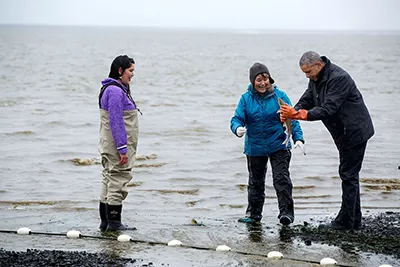
March 7, 2015
Race and the Presidency, from Ferguson to Selma
On March 7, 2015, the First Family traveled to Selma, Alabama to commemorate the 50th anniversary of the marches from Selma to Montgomery.

President Obama Delivers Remarks on the 50th Anniversary of the Selma Marches
“ We honor those who walked so we could run. We must run so our children soar. And we will not grow weary.”
–President Barack Obama, March 7, 2015

Invested in Neighborhoods and Communities
On April 30, 2010, the U.S. Department of Education launched the Promise Neighborhood program and designated 22 Promise Zones across the country to revitalize communities by attracting private investment, creating jobs, improving access to affordable housing, expanding educational opportunities, and partnering with local leaders to navigate federal programs.
In July 2011, the Obama Administration launched Strong Cities, Strong Communities Initiative (SC2), a partnership between the federal government and mayors of chronically distressed cities that have faced significant long-term challenges in developing and implementing their economic strategies. As part of the President’s priority to strengthen the middle class, create jobs, and build ladders of opportunity as communities regain their economic footing, SC2 named 14 locations to receive technical advice and expertise from federal inter-agency teams.
In 2015, the White House launched “Rural Impact,” a cross-agency effort led by the White House Rural Council to combat poverty and improve upward mobility in rural and tribal places by innovating program delivery in key programs, including designating ten rural communities for a demonstration that will provide targeted technical assistance to help communities adopt a two-generation approach to programs, policies, and systems to better meet the needs of low-income kids and parents.

President Obama Announces the First Five Promise Zones
June 2015
Reduced the Medicaid Coverage Gap
The Obama Administration expanded Medicaid to all previously ineligible adults with incomes under 133 percent of the federal poverty level with unprecedented federal support (the Supreme Court directed that this expansion be at the discretion of states).
The U.S. has seen the sharpest reduction in the uninsured rate since the decade following the creation of Medicare and Medicaid in 1965, and the nation’s uninsured rate is now at its lowest level ever.
Helped Small Businesses Get Back on Track
President Obama used proceeds from the Troubled Asset Relief Program (TARP) to stabilize banks that lend to small businesses, and his Administration established two new small business credit programs—the State Small Business Credit Initiative and the Small Business Lending Fund.
Additionally, his Administration focused on strengthening small businesses by signing into law 18 tax cuts for small businesses, ranging from 100% expensing to the small business health tax credit, to the temporary tax exclusion of capital gains from key small business investments.
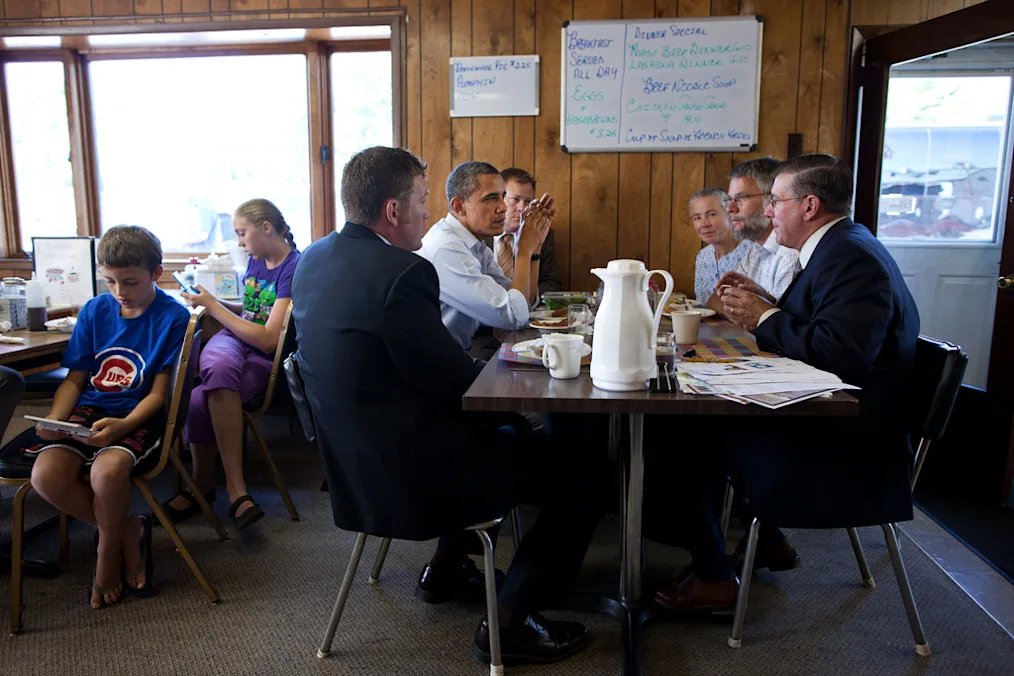

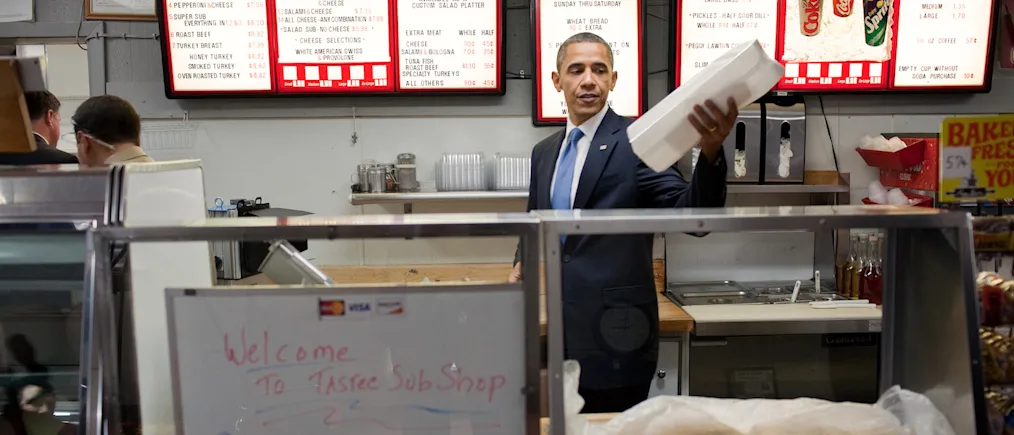
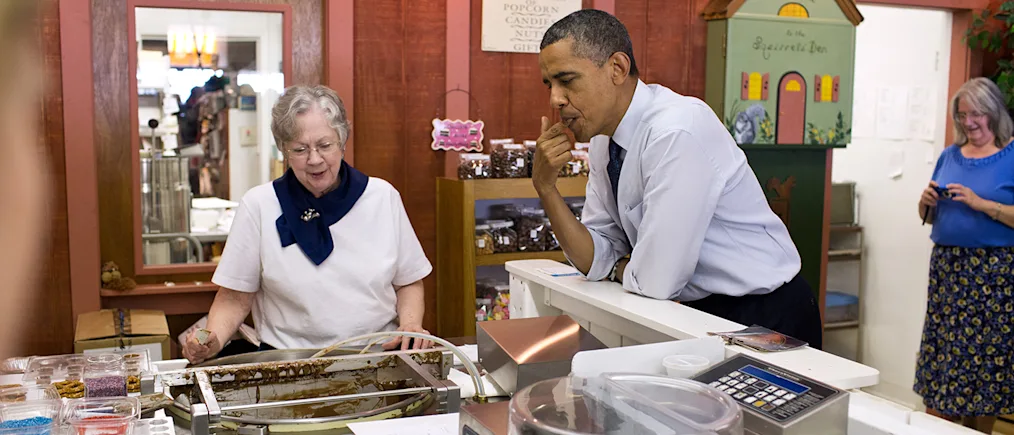
Ensured Equality for LGBT Americans
In December 2010, the President signed the Don’t Ask, Don’t Tell Repeal Act of 2010 into law, allowing gay men and women to serve openly and with integrity in the U.S. military.
In February 2011, the Administration announced it would cease legal defense of the Defense of Marriage Act’s provision defining marriage as only between a man and woman, leading to the Supreme Court’s landmark decisions holding the Act unconstitutional.
Throughout his presidency, President Obama advocated in favor of a Constitutional guarantee of marriage equality for same-sex couples—a position the Supreme Court vindicated in its historic decision in Obergefell v. Hodges in 2015.

The President Speaks on the Supreme Court’s Decision on Marriage Equality

“ We, the people, declare today that the most evident of truths — that all of us are created equal — is the star that guides us still; just as it has guided our forebears through Seneca Falls, and Selma, and Stonewall... That is our generation's task — to make these words, these rights, these values of life and liberty and the pursuit of happiness real for every American.”
–President Barack Obama, Second Inaugural Address, January 21, 2013
June 25, 2015
The Supreme Court Upheld the Affordable Care Act
On June 25, 2015, the Supreme Court issued a 6-3 decision on King v. Burwell, upholding a key part of the Affordable Care Act. Millions of Americans who got covered in health insurance marketplaces would be able to stay covered, no matter where they lived.
Bolstered Preventive Care
The Affordable Care Act created new incentives to promote workplace wellness programs and encourages employers to take more opportunities to support healthier workplaces. Effective for plan years after January 1, 2014, final rules allowed the maximum reward to employers using a health-contingent wellness program to increase from 20 percent to 30 percent of the cost of health coverage, and the maximum reward for programs designed to prevent or reduce tobacco use would be as much as 50 percent.
The Obama Administration eliminated out-of-pocket costs for recommended preventive services, including depression screenings for adults and adolescents, through the Affordable Care Act, and required the posting of calorie information on menus of chain restaurants with 20 or more locations and vending machines.
Invested in Clean Energy
In June 2015, the Obama Administration launched the Clean Energy Investment Initiative to expand private-sector investment in promising technologies aimed at reducing carbon pollution, including inspiring more than $4 billion in private-sector commitments and executive actions to scale up investment in clean-energy innovation.
The Administration also dedicated new federal resources for economic diversification, job creation, training, and other employment services for workers and communities impacted by layoffs at coal mines and coal-fired power plants.
Finally, President Obama committed to combating climate change to protect future generations while supporting a strong rural economy, as climate change was already affecting rural communities across the country and putting homes, businesses, and vital infrastructure at risk. In response, the U.S. Department of Agriculture announced a new investment in nearly 550 renewable energy and energy efficiency projects across the country totaling nearly $7 million in funding through its Rural Energy for America Program (REAP).

Invested in Climate Resilience
The Obama Administration developed the Climate Resilience Toolkit, a website to provide centralized, authoritative, easy-to-use information to help communities prepare for the impacts of climate change. The President also supported expanded use of green infrastructure techniques to improve natural management of stormwater and boost community resilience to flooding and other impacts of climate change.
To enhance commitments to building resilience in vulnerable communities disproportionately affected by the impacts of climate change — many of which are already facing economic or health-related challenges — the Administration and its partners announced the first-ever Resilience AmeriCorps. The two-year pilot program recruited, trained, and embedded AmeriCorps VISTA members in ten communities across the country to increase civic engagement and community resilience in low-income areas, and help those communities develop plans for becoming more resilient to any number of shocks and stresses, including better preparations for extreme weather events.
August 24, 2015
Reduced the Government’s Emissions
President Obama was committed to addressing the climate change threat — both by taking action here at home and showing leadership on the world stage.
As part of his commitment to lead by example to curb the emissions that are driving climate change, President Obama issued an Executive Order to cut the Federal Government’s greenhouse gas (GHG) emissions 40 percent over the next decade from 2008 levels — saving taxpayers up to $18 billion in avoided energy costs — and increased the share of electricity the Federal Government consumes from renewable sources to 30 percent. Complementing this effort, several major Federal suppliers announced commitments to cut their own GHG emissions.
Together, the combined results of the Federal Government actions and new supplier commitments will reduce GHG emissions by 26 million metric tons by 2025 from 2008 levels, the equivalent of taking nearly 5.5 million cars off the road for a year.
Meeting People Where They Are: on SnapChat, Instagram and More
President Obama is the first “social media president”: the first to have @POTUS on Twitter, the first to go live on Facebook from the Oval Office, the first to answer questions from citizens on YouTube, the first to use a filter on Snapchat. Over the past eight years, the President, Vice President, First Lady, and the White House have used social media and technology to engage with people around the country and the world on the most important issues of our time (while having some fun along the way).
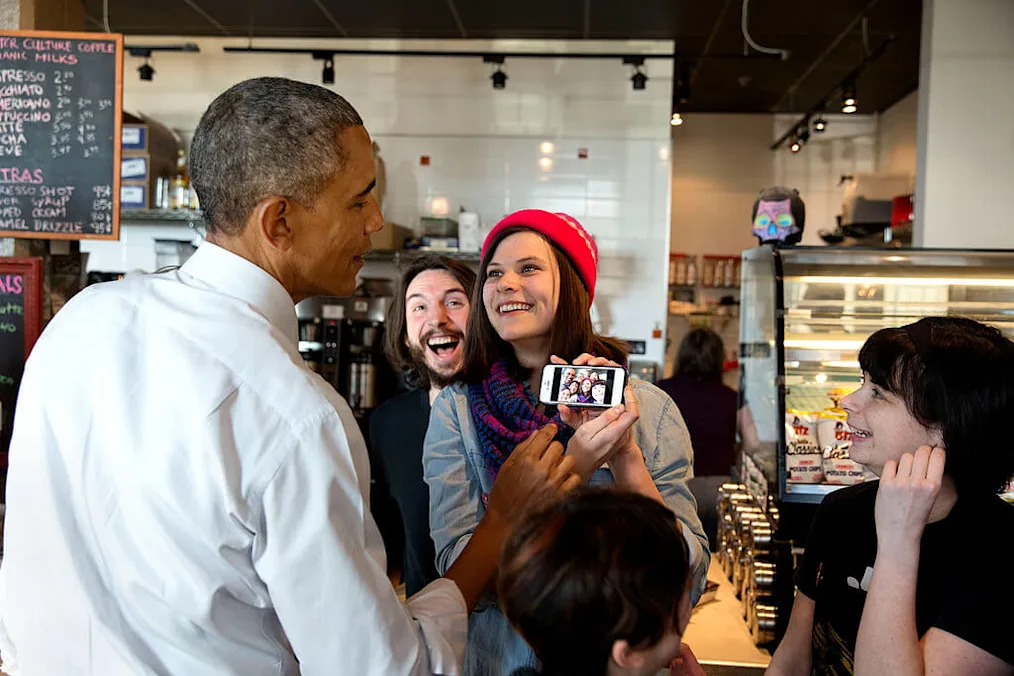

@POTUS: The First Tweet
Preserved Open Spaces and Endangered Species
Early in his tenure, President Obama signed the Omnibus Public Land Management Act of 2009, the most extensive expansion of land and water conservation in more than a generation, which designated more than 2 million acres of Federal wilderness and protected thousands of miles of trails and more than one thousand miles of rivers.
Committed to giving every kid the chance to explore America’s great outdoors and unique history, President Obama also launched an “Every Kid in a Park” initiative that provided all fourth-grade students and their families free admission to all Federal lands and waters for a full year.
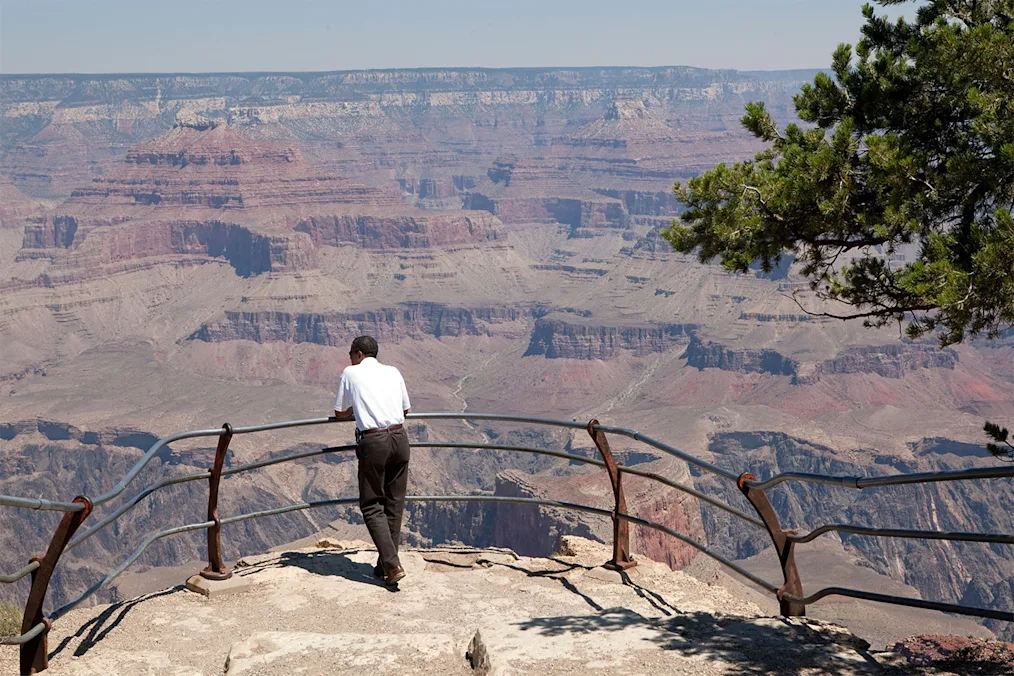
October 5, 2015
Negotiated the Trans-Pacific Partnership
The Obama Administration negotiated and concluded the Trans-Pacific Partnership (TPP), a 12-country agreement representing nearly 40 percent of global economic output, to increase American trade with the fastest growing region in the world, based on an open, transparent, and level playing field.
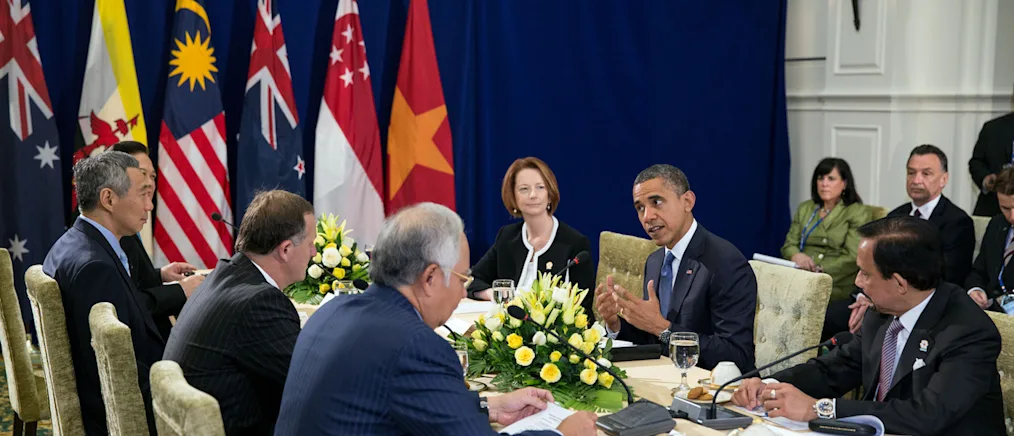
December 12, 2015
Led the Paris Agreement
The Obama Administration led a global effort to achieve the Paris Agreement among 196 countries to take real action on climate change that calls for strong transparency, ensuring countries adhere to ambitious emissions reduction goals, and setting the world on a course to cut carbon pollution and other greenhouse gases.
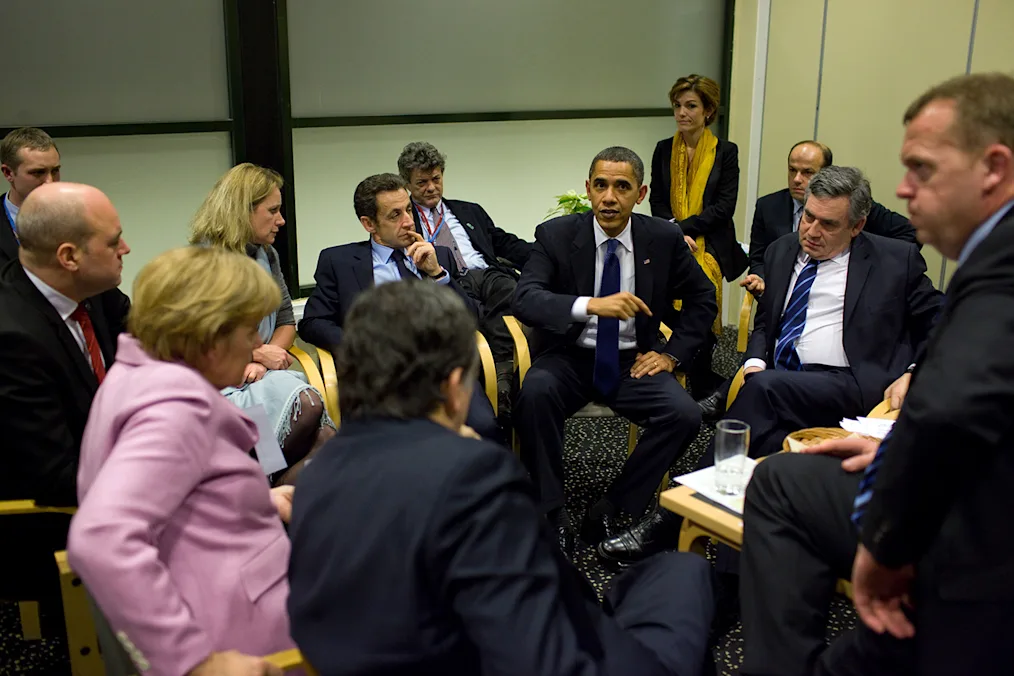
January 4, 2016
Took Action on Gun Violence
Gun violence has taken a heartbreaking toll on too many communities across the country. Over the past decade in America, more than 100,000 people have been killed as a result of gun violence—and millions more have been the victim of assaults, robberies, and other crimes involving a gun. Many of these crimes were committed by people who never should have been able to purchase a gun in the first place.President Obama and Vice President Biden were committed to using every tool at the Administration’s disposal to reduce gun violence.The Obama Administration directed an overhaul of the background check system to make it more efficient and effective. The Administration clarified that it doesn’t matter where you conduct your business—from a store, at gun shows, or over the Internet: If you’re in the business of selling firearms, you must get a license and conduct background checks. The Administration also ensured States are providing records to the background check system, and work cooperatively with jurisdictions to improve reporting.Additionally, the Administration issued a memo directing every U.S. Attorney’s Office to renew domestic violence outreach efforts, and called for significant new resources to increase access to mental health care.
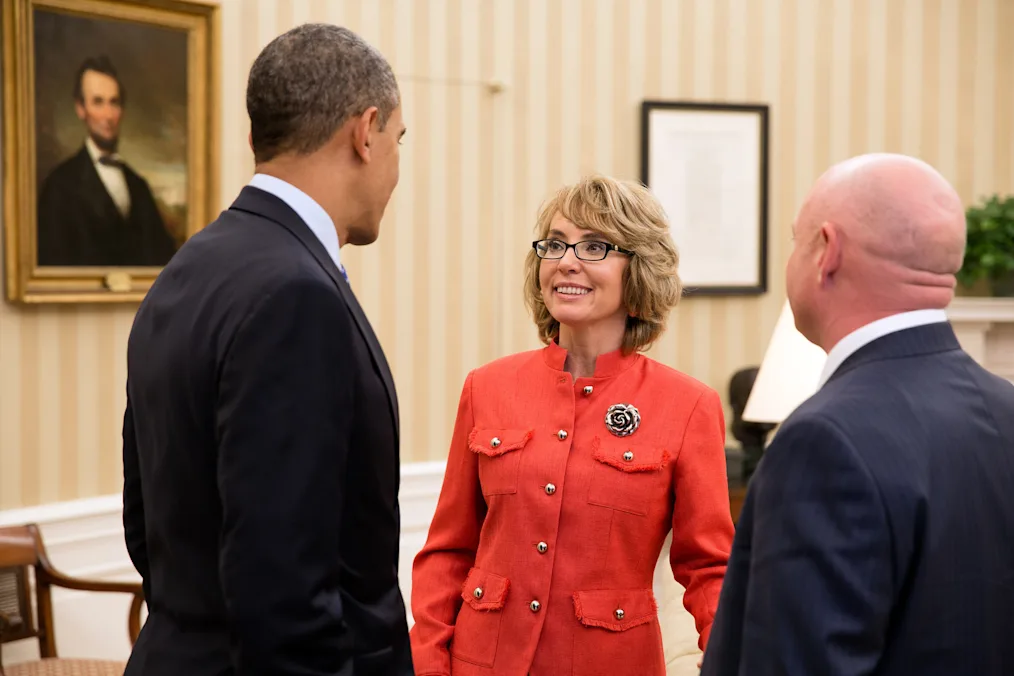
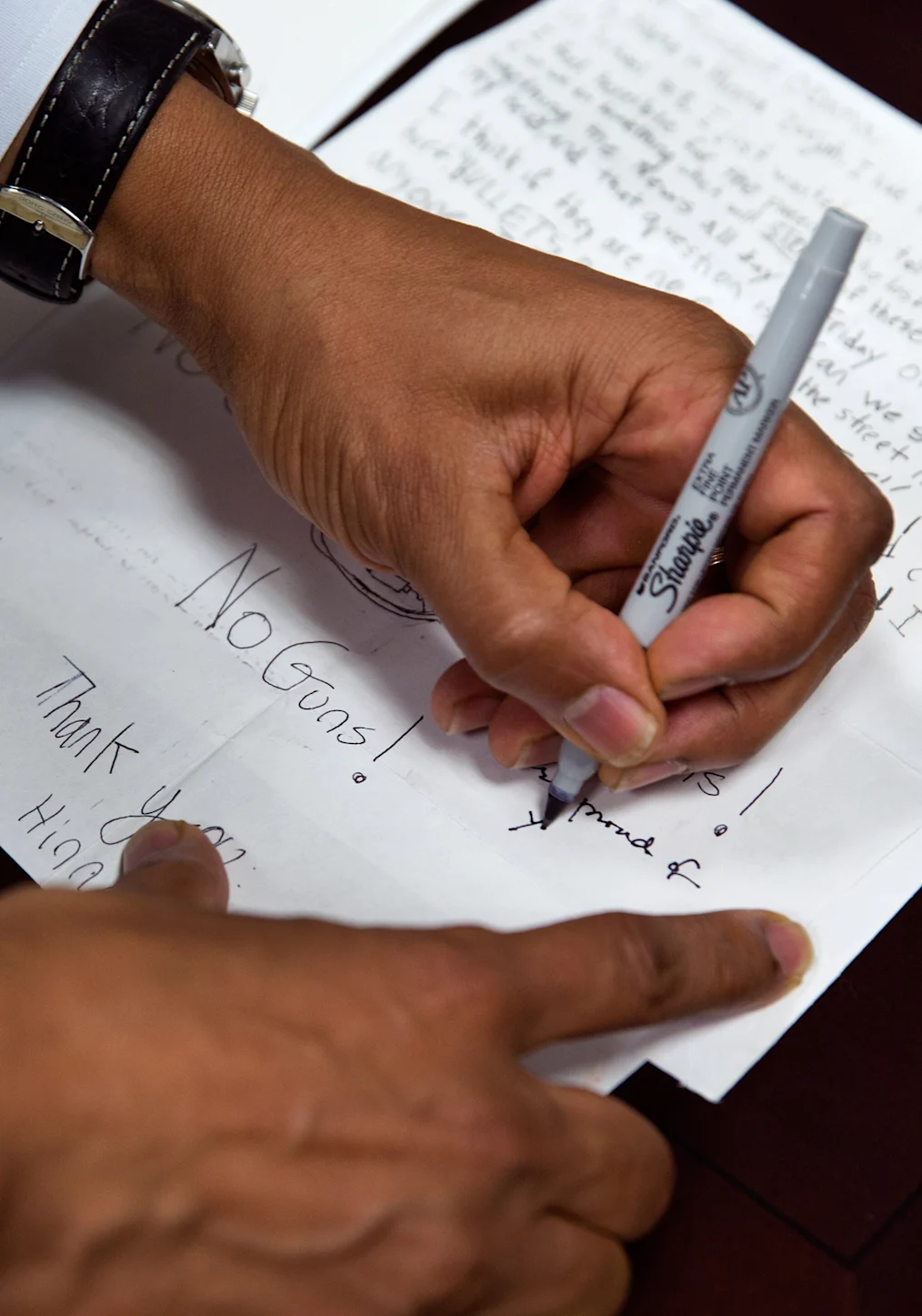
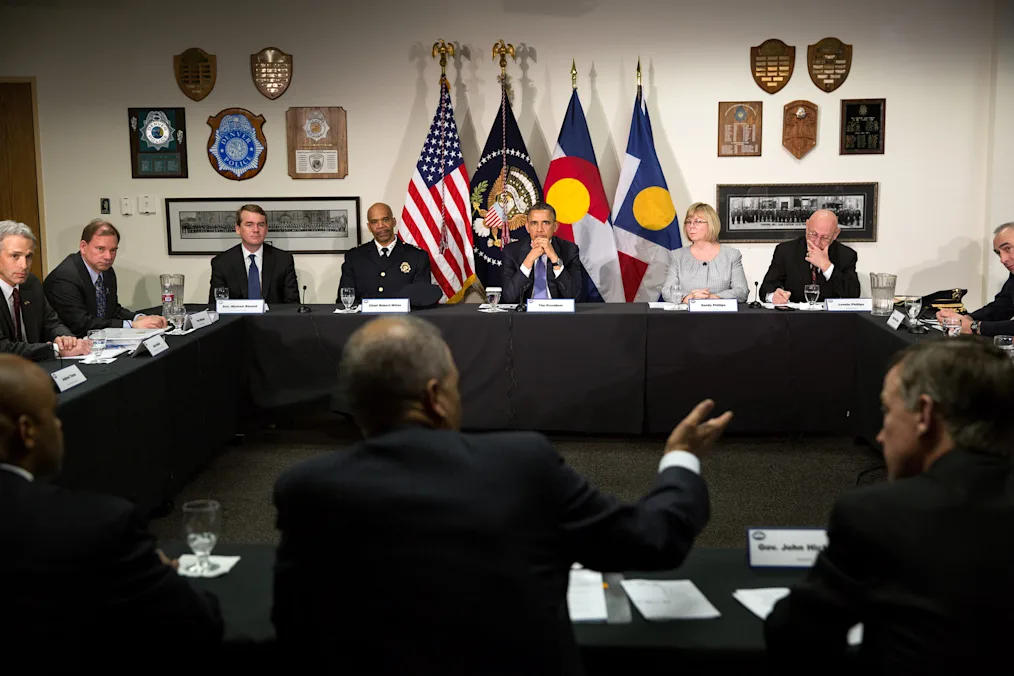
Responded to Ebola
The Obama Administration developed a comprehensive, intergovernmental strategy to combat outbreaks of the flu (H1N1), Ebola, and other infectious diseases.
The Ebola outbreak in West Africa grew into the deadliest one the world has ever seen — and the President committed to treating and tackling Ebola as both a national security priority, and an example of American leadership.
The U.S. built, coordinated, and led a worldwide response to the Ebola outbreak while strengthening our preparedness here at home. And thanks to the hard work of our military members, civilian responders, and health care workers, we dramatically bent the curve of the epidemic. Cases went down 80 percent from peak levels.
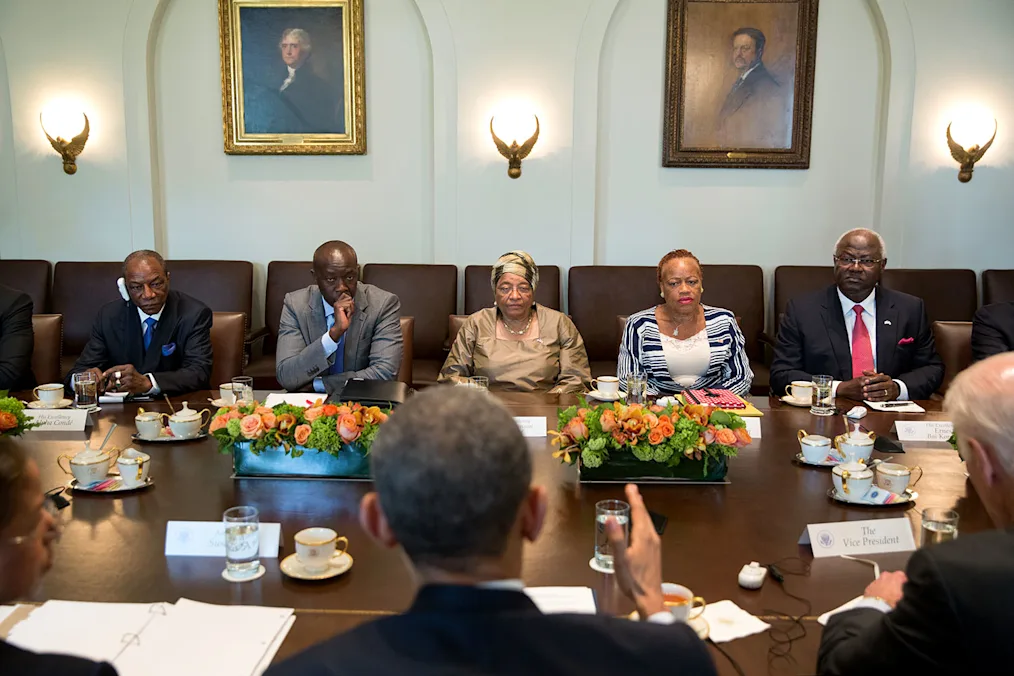
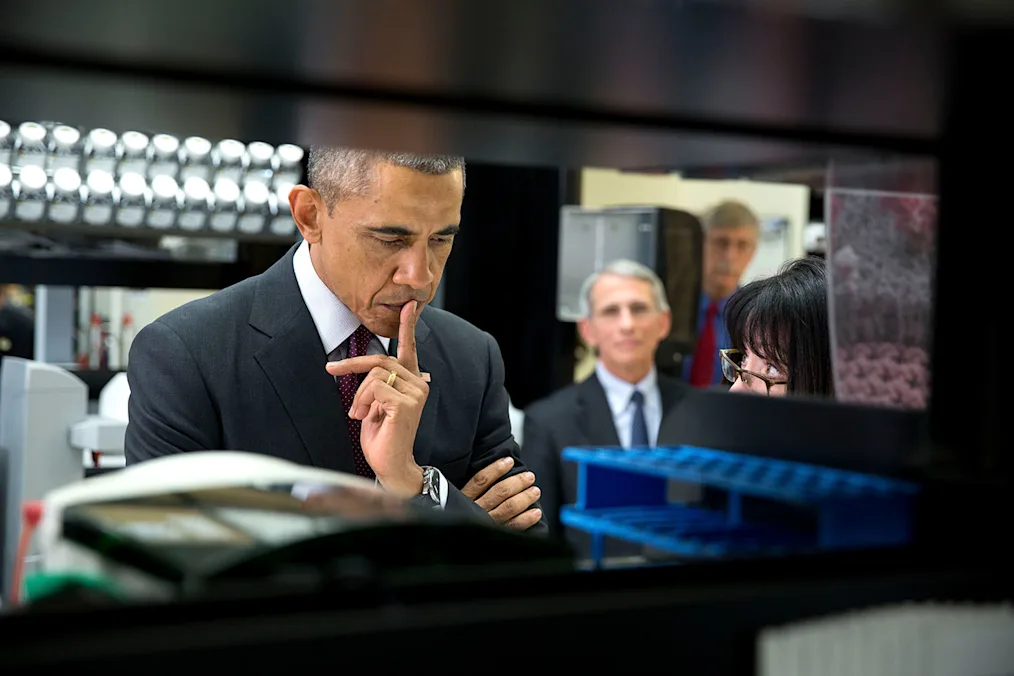
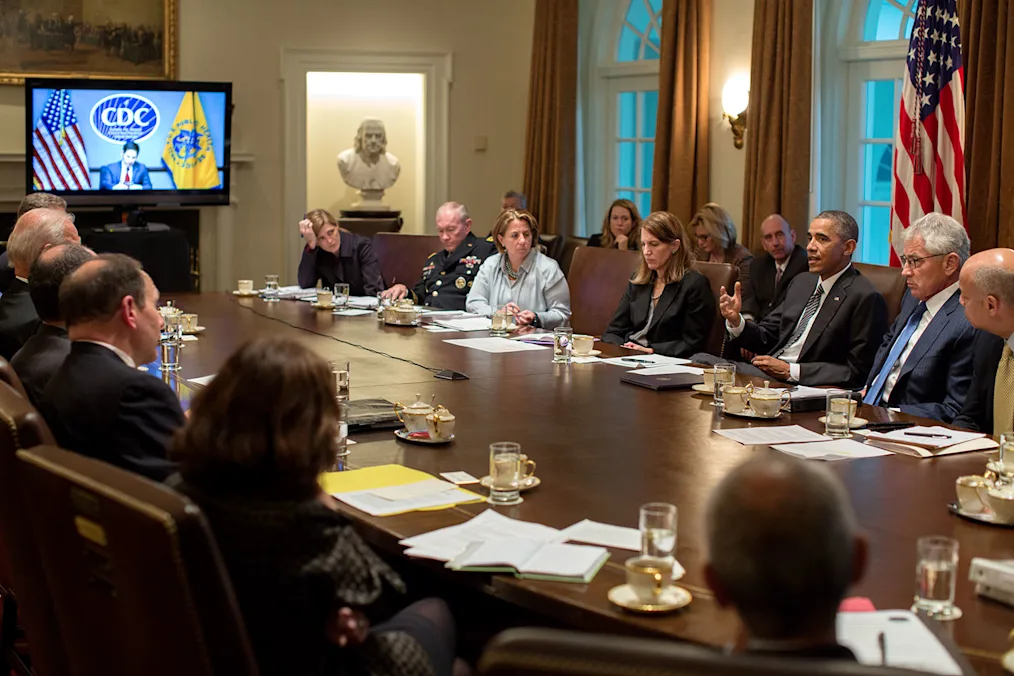
Removed Discrimination from Health Care
The Affordable Care Act prohibited coverage denials and reduced benefits due to pre-existing conditions. Today, as many as 129 million Americans with pre-existing conditions can no longer be denied health coverage.
The ACA also prohibited charging more for women to receive coverage. Since September of 2013, the uninsured rate for women has dropped nearly 50 percent, meaning that about 9.5 million adult women have gained coverage.
The Affordable Care Act also contained many important benefits for American Indians and Alaska Natives. First and foremost, it includes the permanent reauthorization of the Indian Health Care Improvement Act, ensuring that the IHS is here to stay. It also improved benefits and protections for American Indians and Alaska Natives who have insurance, whether they receive care inside or outside the IHS. And it gives them more choices for health coverage, including Medicaid and the Federal Employees Health Benefits Program.
Supported the FCC’s Net Neutrality Decision
President Obama supported the FCC’s “net neutrality” decision to adopt the strongest rules possible to ensure Internet Service Providers (ISPs) cannot become gatekeepers to the Internet’s content or create paid fast lanes for access to the best services.

President Obama's Statement on Keeping the Internet Open and Free
Formed a Coalition to Degrade and Destroy ISIL
The terrorist group known as ISIL was formerly al Qaeda’s affiliate in Iraq. Though it calls itself the “Islamic State,” it is neither Islamic nor a state. It is a terrorist organization that has perverted a religion into a dangerous ideology.
On September 10, 2014, President Obama announced the formation of a broad international coalition to defeat ISIL. Since then, the United States has led 66 international partners in a global coalition to counter ISIL with a focus on liberating ISIL-controlled territory in Iraq and Syria. The mission was aimed at striking ISIL at its core, degrading its networks, and constraining its prospects for expansion.
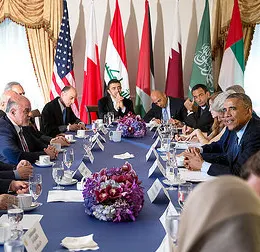
1/3
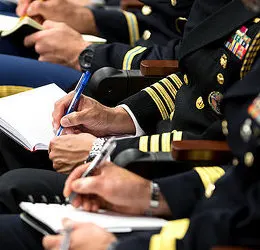
2/3
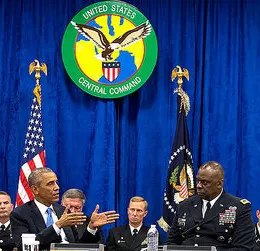
3/3
October 3, 2016
SXSL: South by South Lawn
In March 2016, President Obama traveled to South by Southwest® for a conversation on civic engagement. In Austin, he called on creative thinkers and entrepreneurs from across the country to help tackle our toughest challenges. On October 3, 2016, we celebrated that spirit of innovation at South by South Lawn, a White House festival of ideas, art, and action.
At SXSL, we celebrated the inspiring work that so many Americans have already accomplished—called on everyone to roll up their sleeves and discover their own way to make a positive difference in our country.

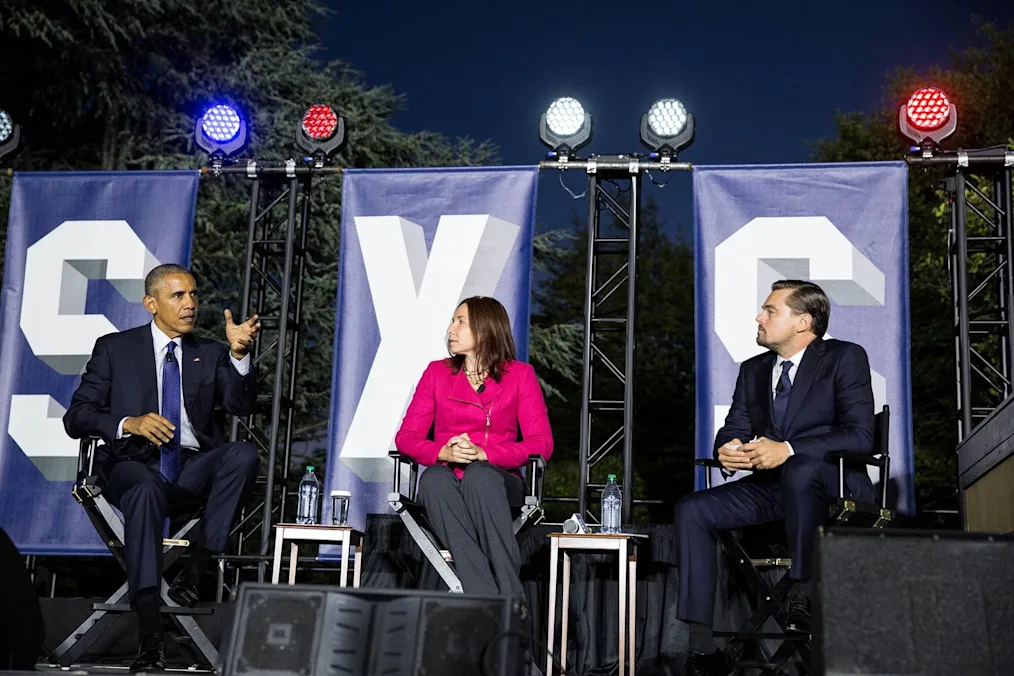
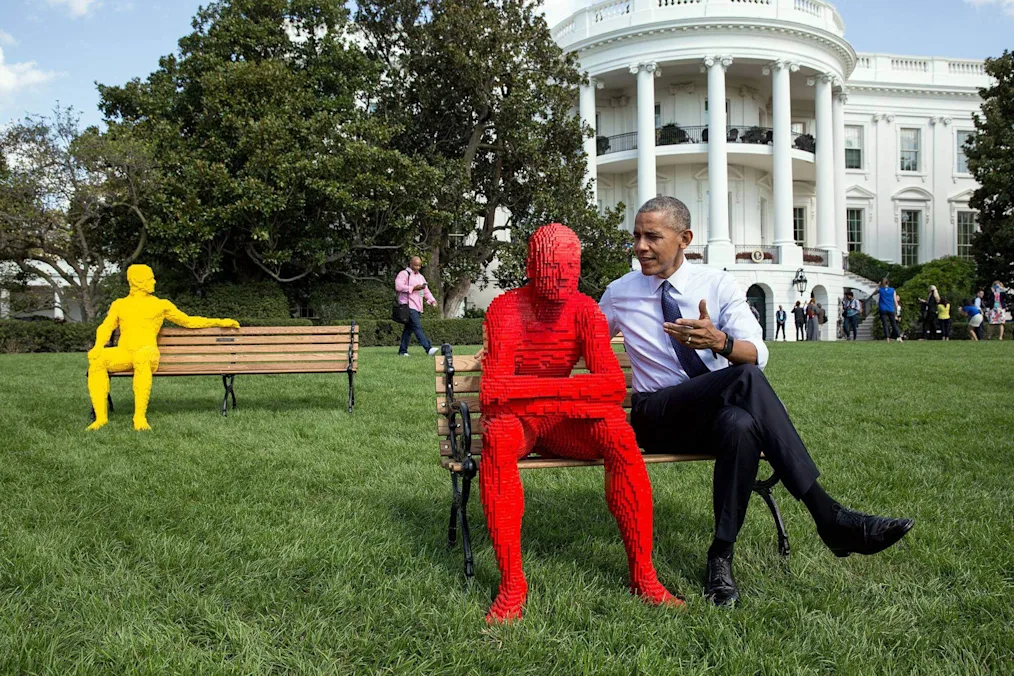
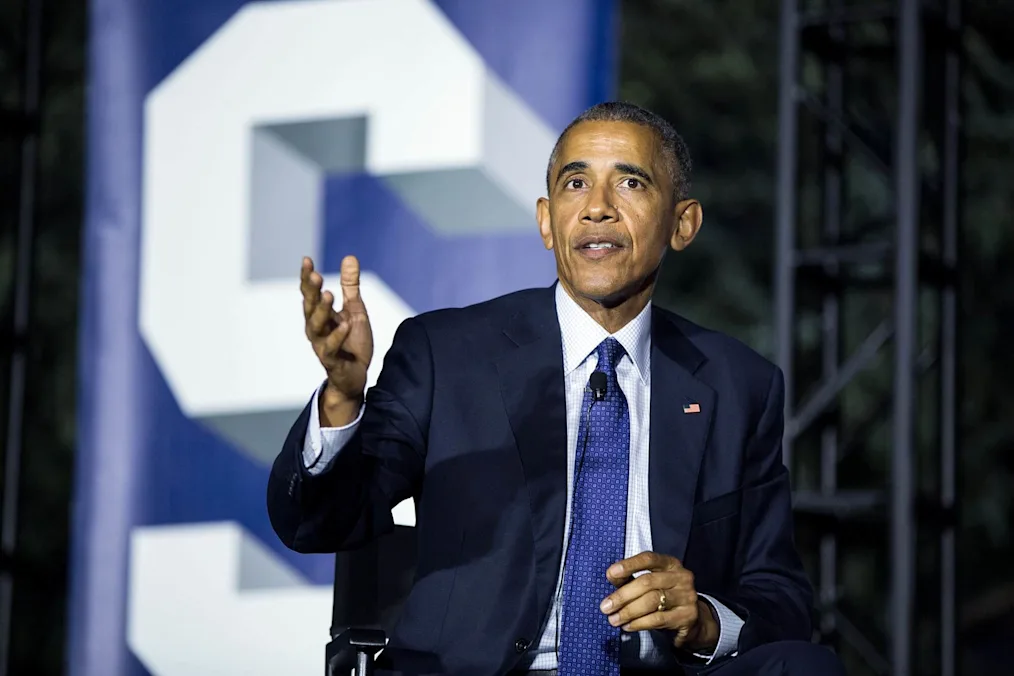
October 12, 2016
Tech Leadership in Popular Culture: Keynoting SXSW & Guest-editing Wired
President Obama traveled to South by Southwest in March 2016 — the first sitting President to do so. In Austin, he made the case for people “from all walks of life, working inside or outside of government, to help us make this democracy even stronger.”
When it comes to tech, the President has had many firsts: the first “Social Media President;” the first President to appoint a Chief Technology Officer; the first President whose White House had built an online civic engagement platform, We The People; the first President with his own tech startups in the United States Digital Service (USDS), 18F, and the Presidential Innovation Fellows. But this Administration’s use of technology is not about novelty. Instead it is rooted in the President’s broader vision about citizenship and service.
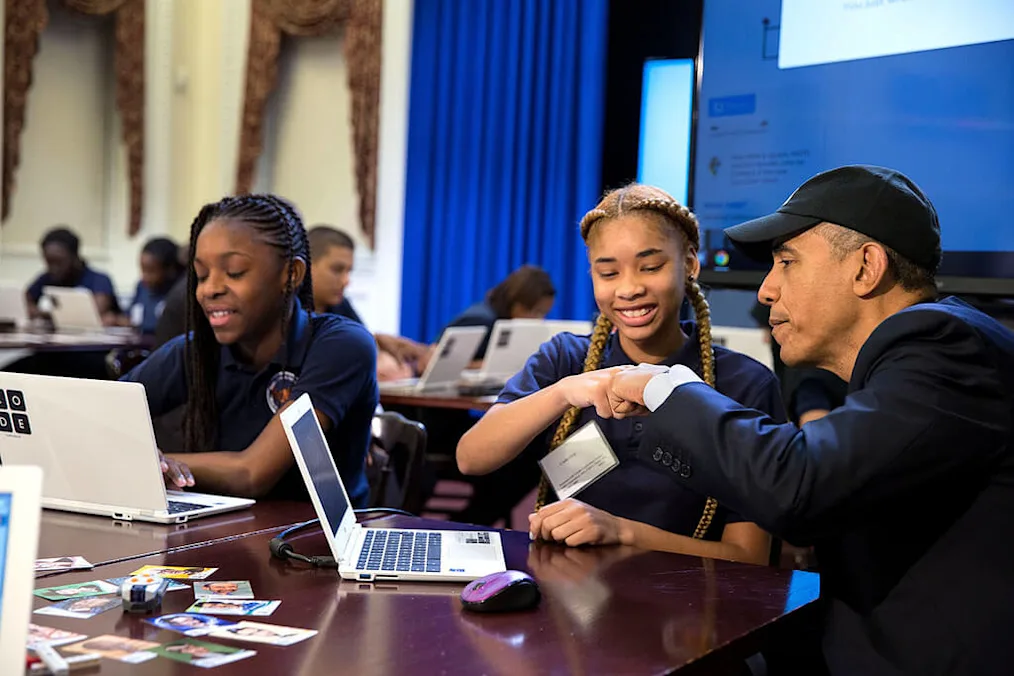
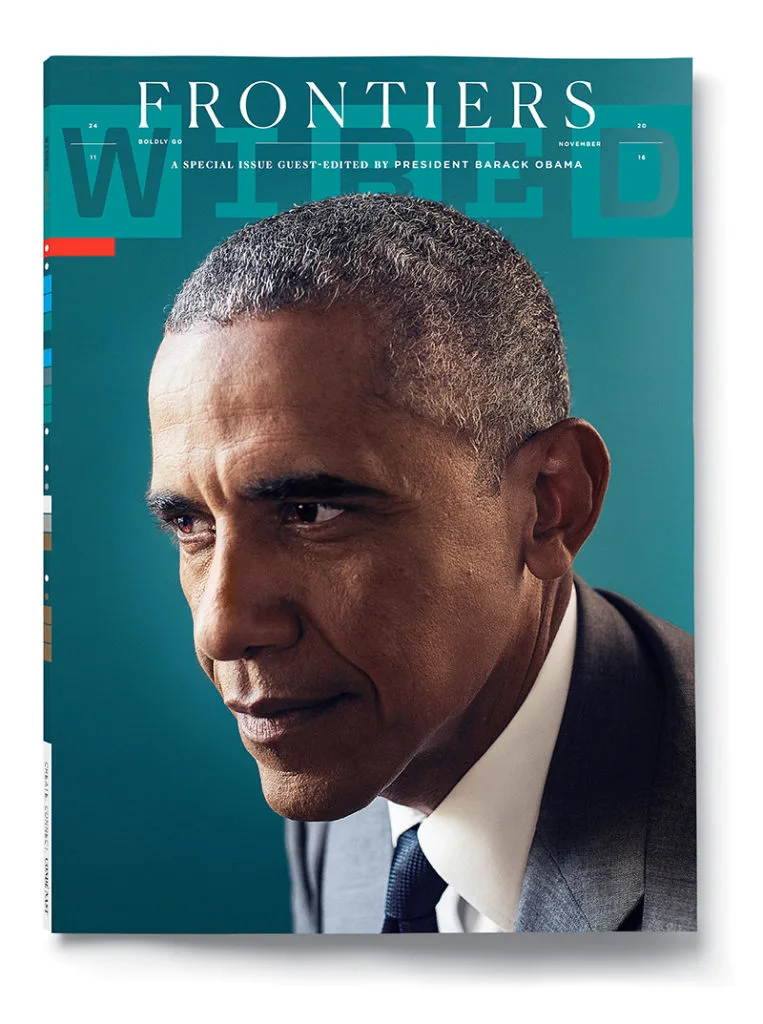
In the November 2016 issue of WIRED, guest-editor President Obama explored the theme of “Frontiers” that will shape the coming decades.
Watch: President Barack Obama's Keynote Conversation at SXSW Interactive (Opens in a new tab)
Made Homes More Efficient
President Obama was committed to taking responsible steps to slow the effects of climate change so we leave behind a cleaner, more stable environment for future generations.
In September 2014, the Administration announced new private sector commitments and executive actions to reduce emissions of hydroflourocarbons (HFCs), powerful greenhouse gases that contribute to climate change. The commitments made in 2014 would reduce cumulative global consumption of these greenhouse gases by the equivalent of 700 million metric tons of carbon dioxide through 2025, equivalent to 1.5% of the world’s 2010 greenhouse gas emissions and the same as taking nearly 15 million cars off the road for 10 years. New energy efficiency standards for appliances and equipment also cut consumers’ electricity bills by hundreds of billions of dollars,
Additionally, President Obama led an international coalition of countries to secure an amendment to the Montreal Protocol to phase down HFCs, potent greenhouse gases. The amendment, which had strong support from U.S. industry, would avoid more than 80 billion metric tons of carbon dioxide equivalent by 2050 — equivalent to more than a decade of emissions from the entire U.S. economy — and could avoid up to 0.5°C of warming by the end of the century.
December 20, 2016
Worked with Canada to Protect the Arctic
On December 20, 2016, in partnership with our neighbors and allies in Canada, the Obama Administration took historic steps to build a strong Arctic economy, preserve a healthy Arctic ecosystem and protect the United States’ fragile Arctic waters, including designating the bulk of our Arctic water and certain areas in the Atlantic Ocean as indefinitely off limits to future oil and gas leasing.
The White House Student Film Festival
Nearly 50 years ago, the American Film Institute (AFI) was born in the White House Rose Garden. Standing just outside the Oval Office, President Lyndon Johnson spoke to the need to bring together “leading artists of the film industry, outstanding educators, and young men and women who wish to pursue the 20th century art form as their life’s work.”
Since that day, new tools and platforms have allowed remarkable voices of a new generation to speak with this art form, and the AFI partnered with the White House in encouraging the young people of America to tell their inspiring tales.

“ In this country, if we give all of our kids the best opportunities and technology and resources, there’s no telling what they’ll create -- now and the years ahead.”
–President Obama, March 2015
Reduced Unemployment Among Veterans
In August 2011, President Obama called on Congress to enact tax credits that will help get veterans back to work. The Returning Heroes Tax Credit provides businesses that hire unemployed veterans with a maximum credit of $5,600 per veteran, and the Wounded Warriors Tax Credit offers businesses that hire veterans with service-connected disabilities with a maximum credit of $9,600 per veteran.
These tax credits were included in the American Jobs Act and were signed into law by President Obama on November 21, 2011.
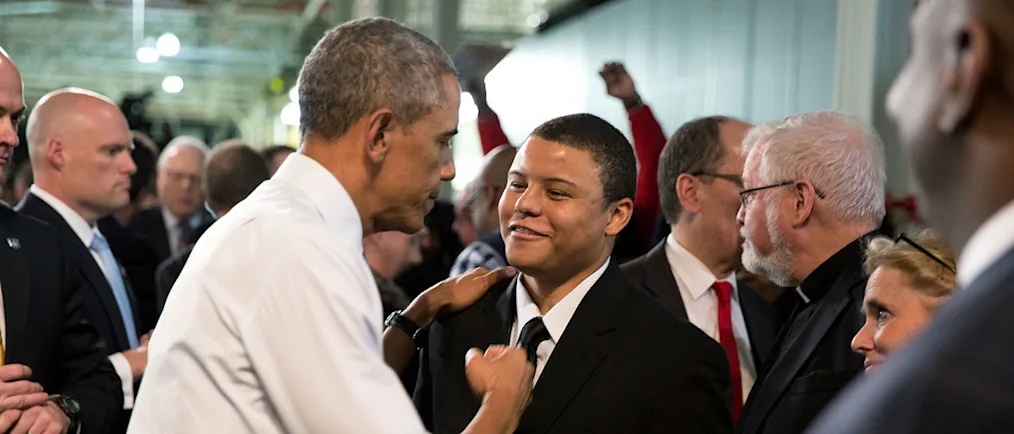
Musical and Arts Performances at the White House
Musical performances at the White House ranged in form, genre, and style. Artists such as Beyoncé, Mick Jagger, Aretha Franklin, B.B. King, and the Mount Ennon Baptist Church Children’s Chorus performed during President Obama’s time in office.

1/17

2/17
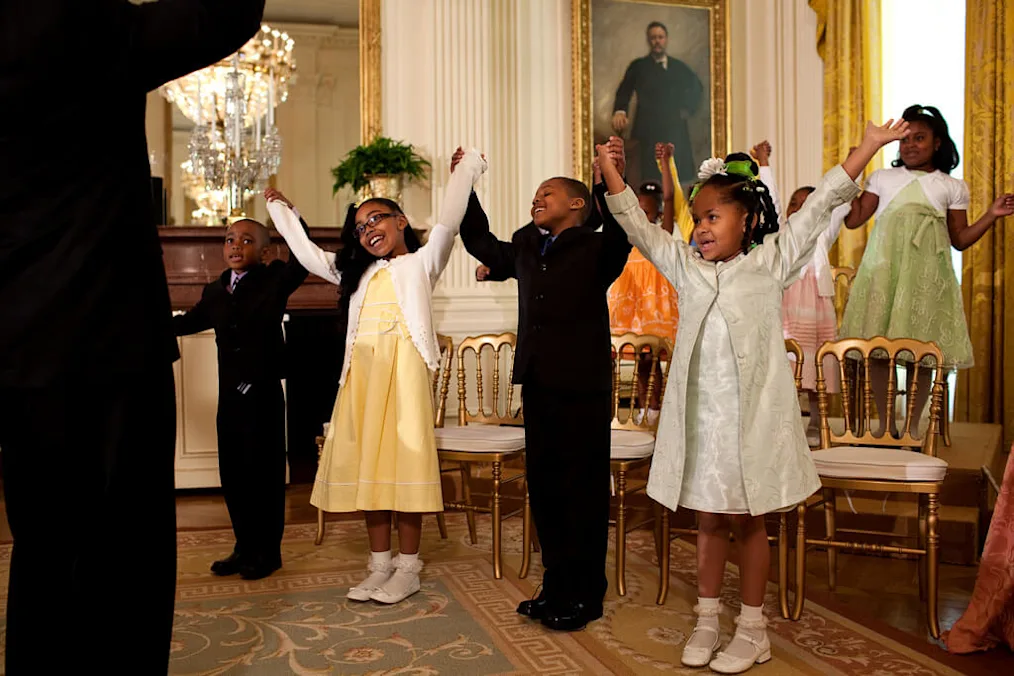
3/17

4/17

5/17
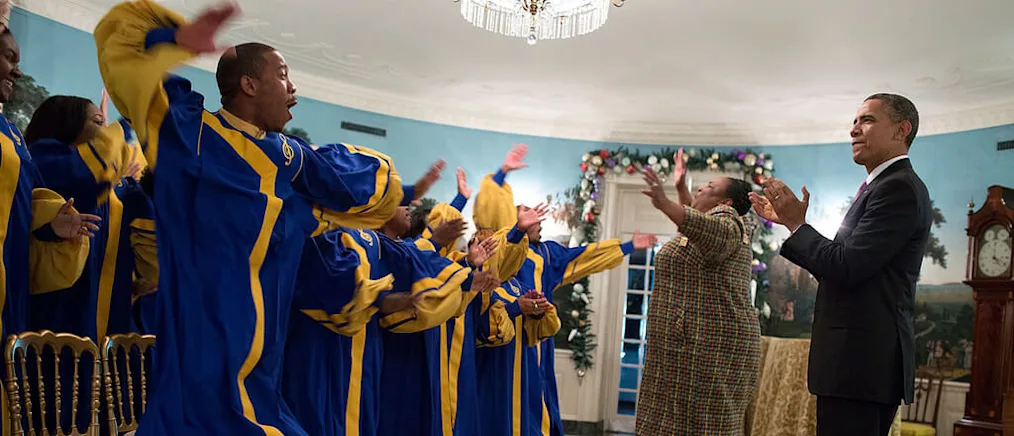
6/17

7/17

8/17
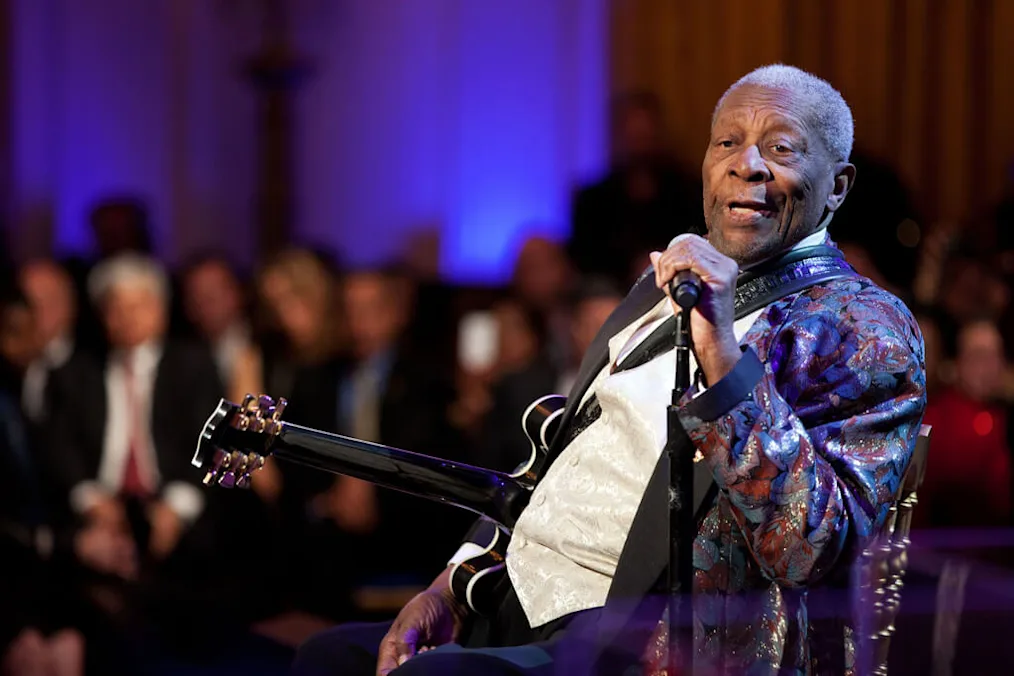
9/17
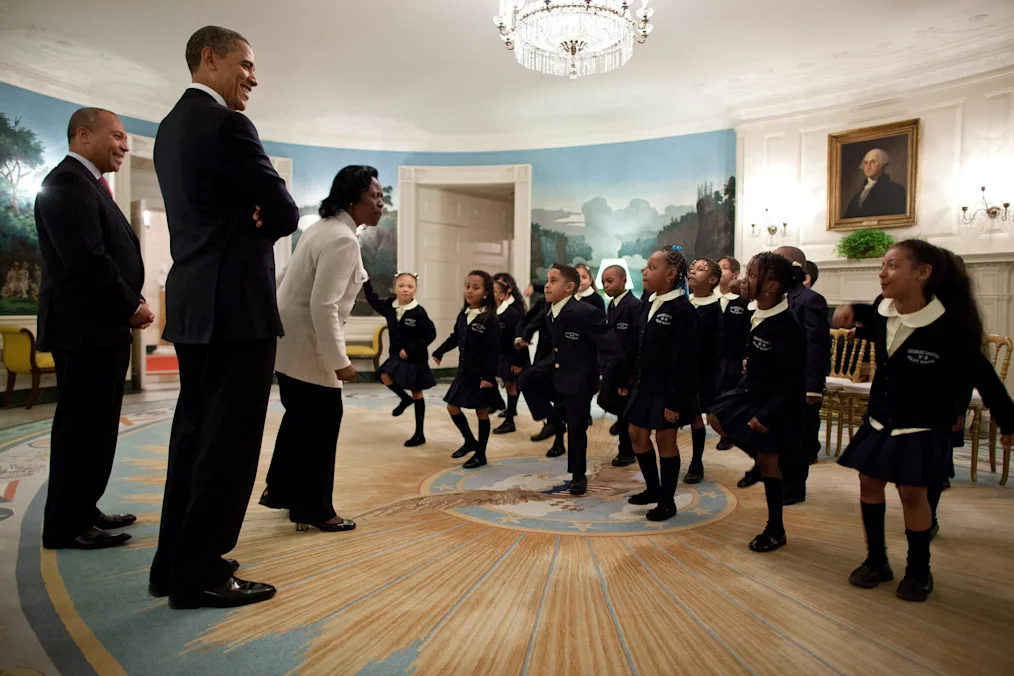
10/17

11/17

12/17

13/17

14/17

15/17

16/17
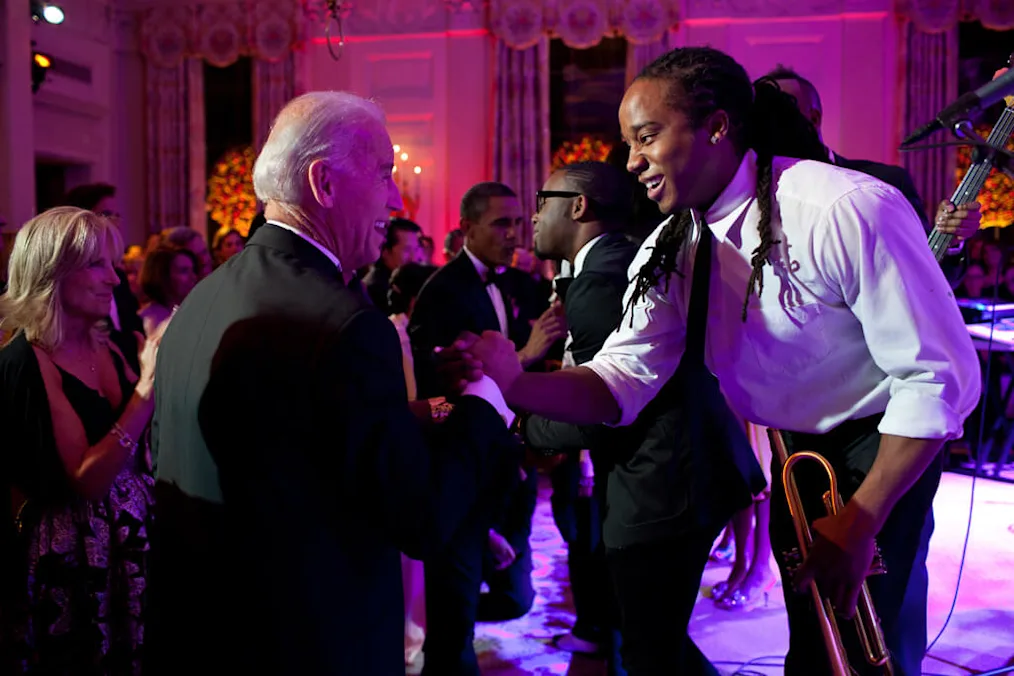
17/17
State Dinners Throughout the Years
In the nineteenth century, the term “State Dinner” was used to denote any affair that honored the President’s Cabinet, Congress, or other dignitaries. However, President Ulysses S. Grant changed the meaning of the term when he welcomed King David Kalakua of the Kingdom of Hawaii in 1874. Now, State Dinners are grand affairs hosted by the President to welcome a visiting head of state.
A State Dinner requires at minimum, six months of preparation. From the guest list and invitations, to the menus and seating arrangements, all require the careful attention of the First Lady, State Department, and White House Social Secretary.

1/8

2/8

3/8
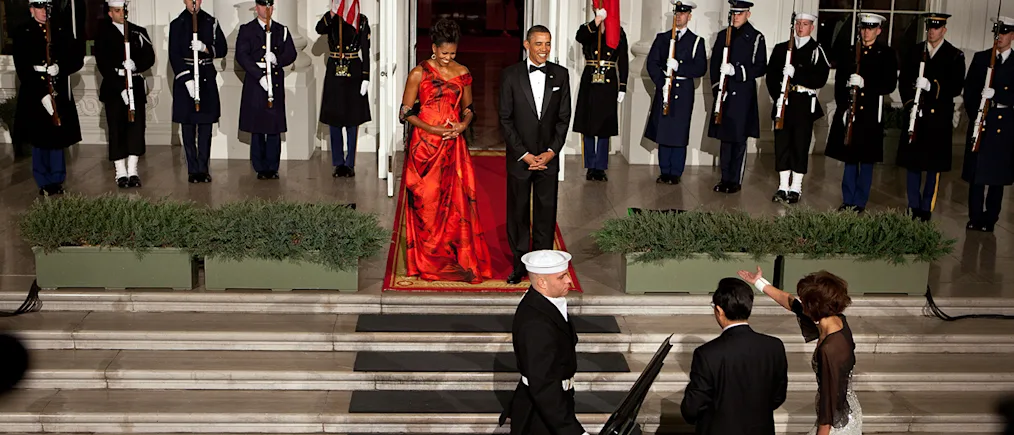
4/8
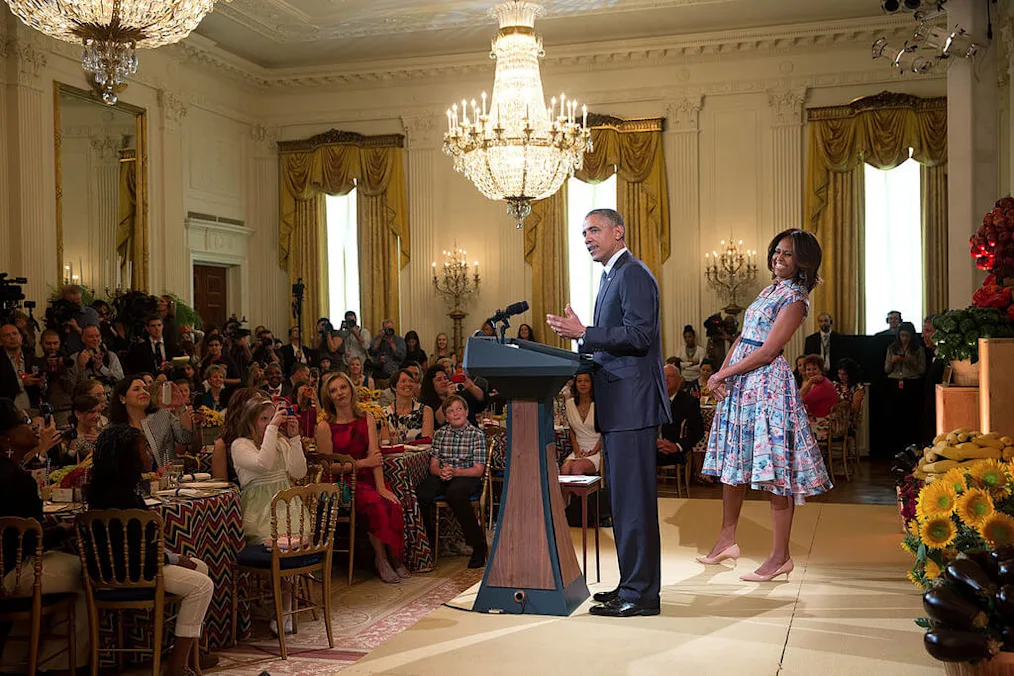
5/8

6/8

7/8
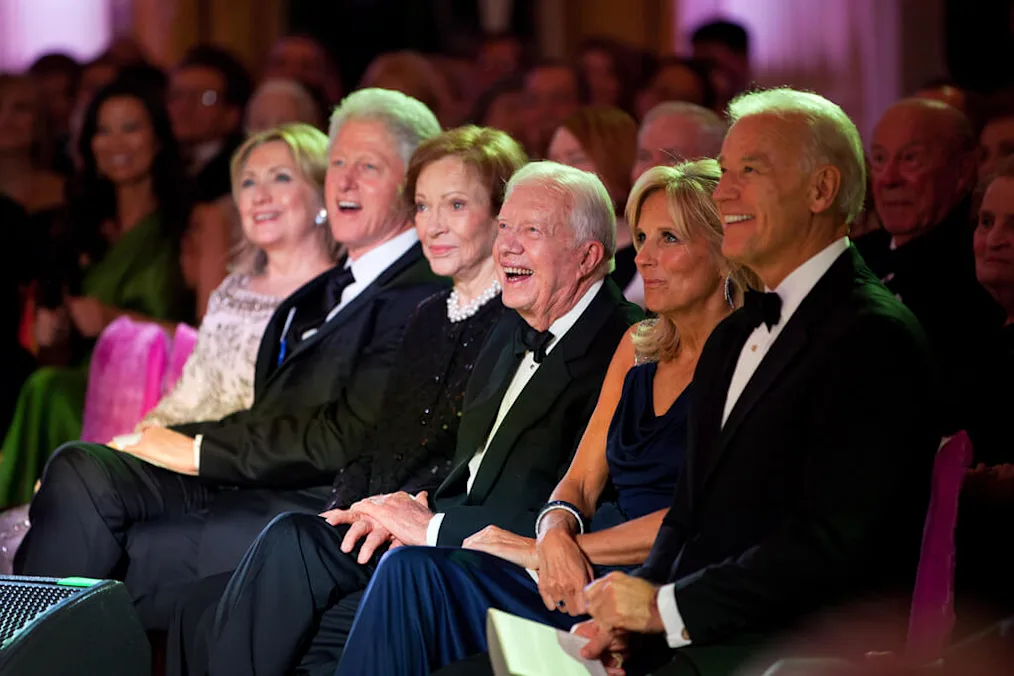
8/8
Celebrations at the Obama White House

1/21

2/21

3/21

4/21
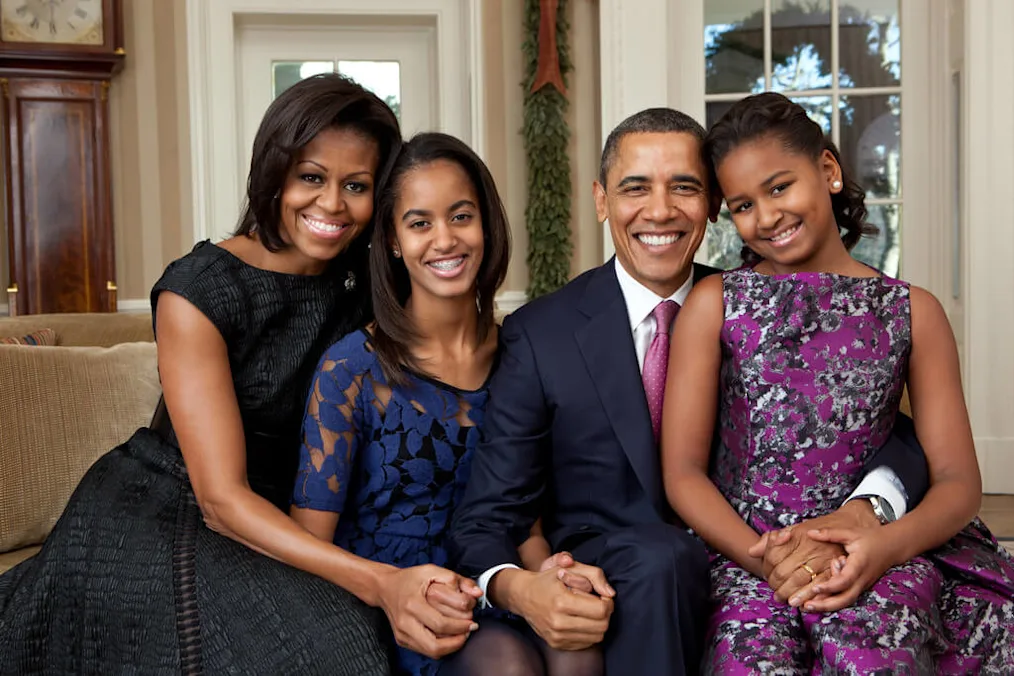
5/21

6/21
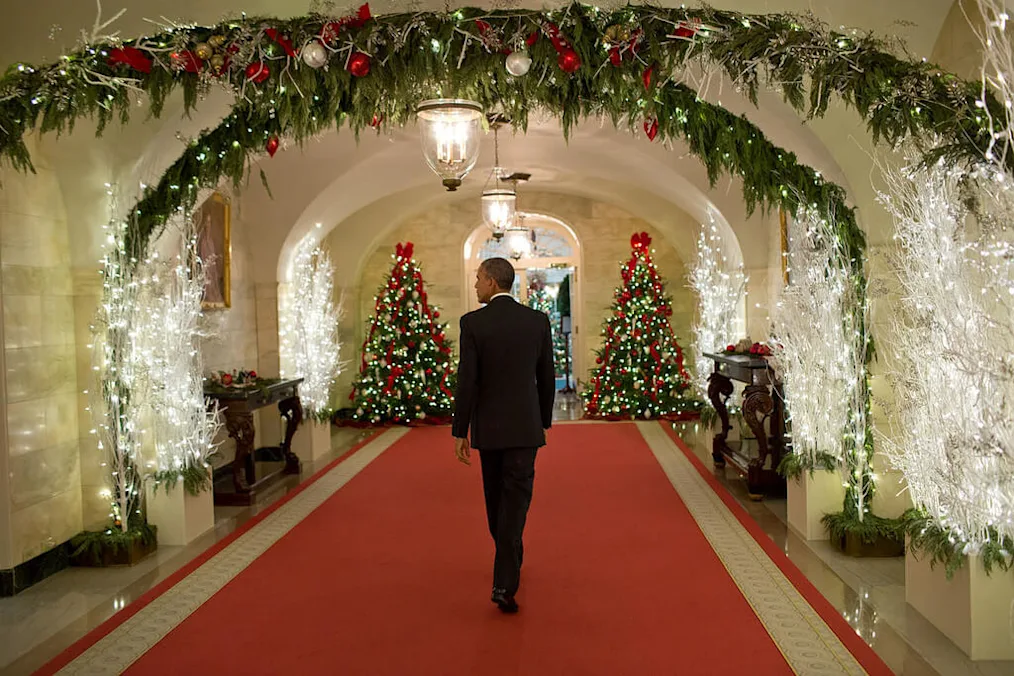
7/21
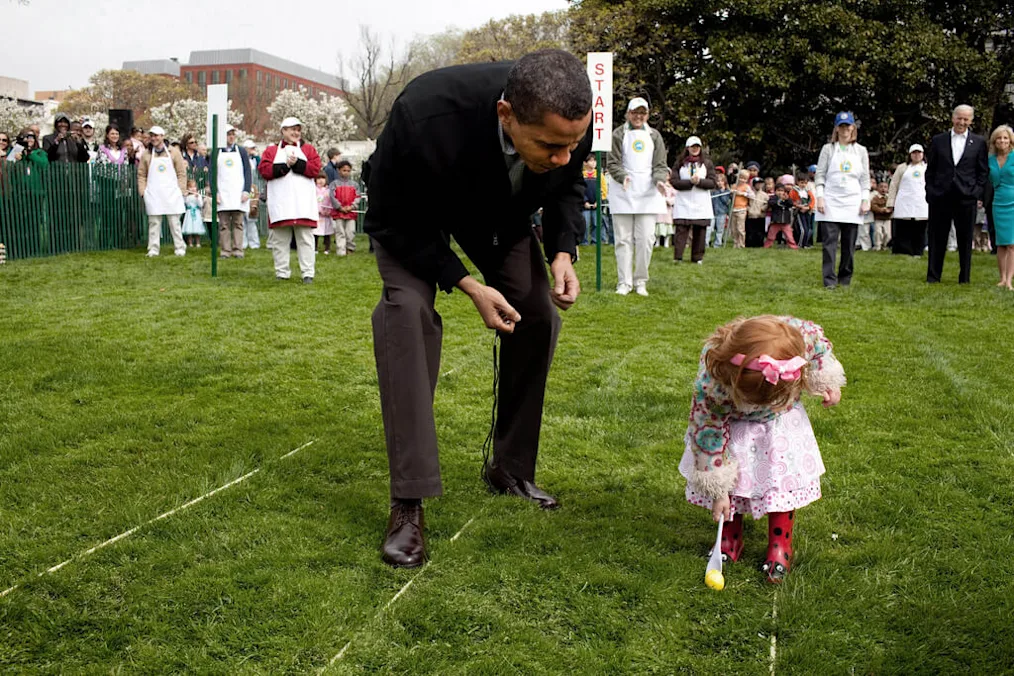
8/21

9/21

10/21

11/21

12/21

13/21
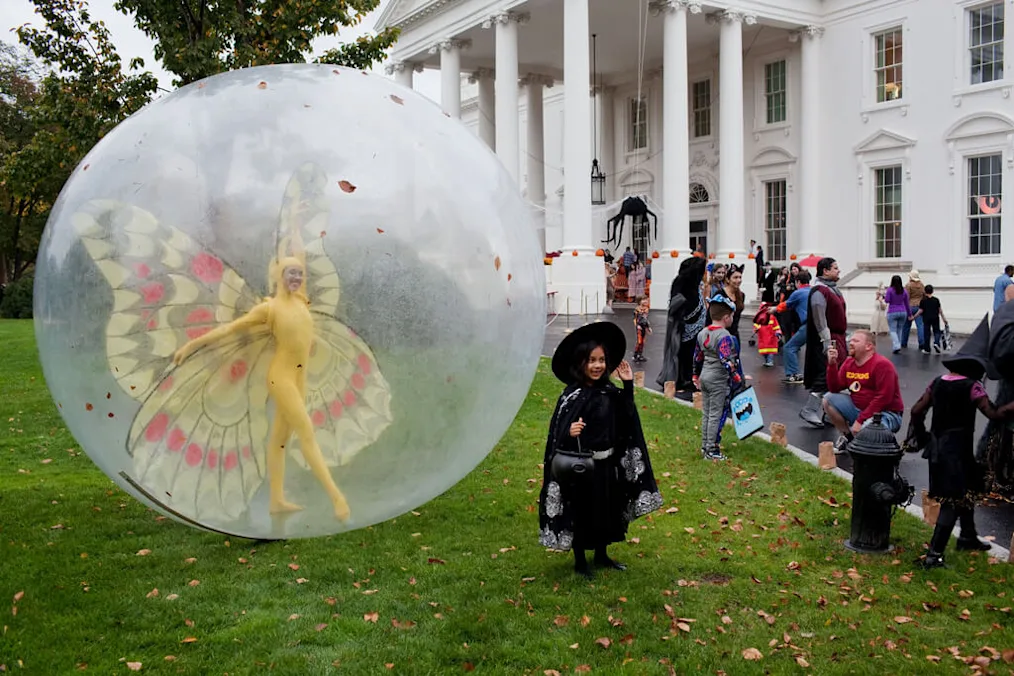
14/21
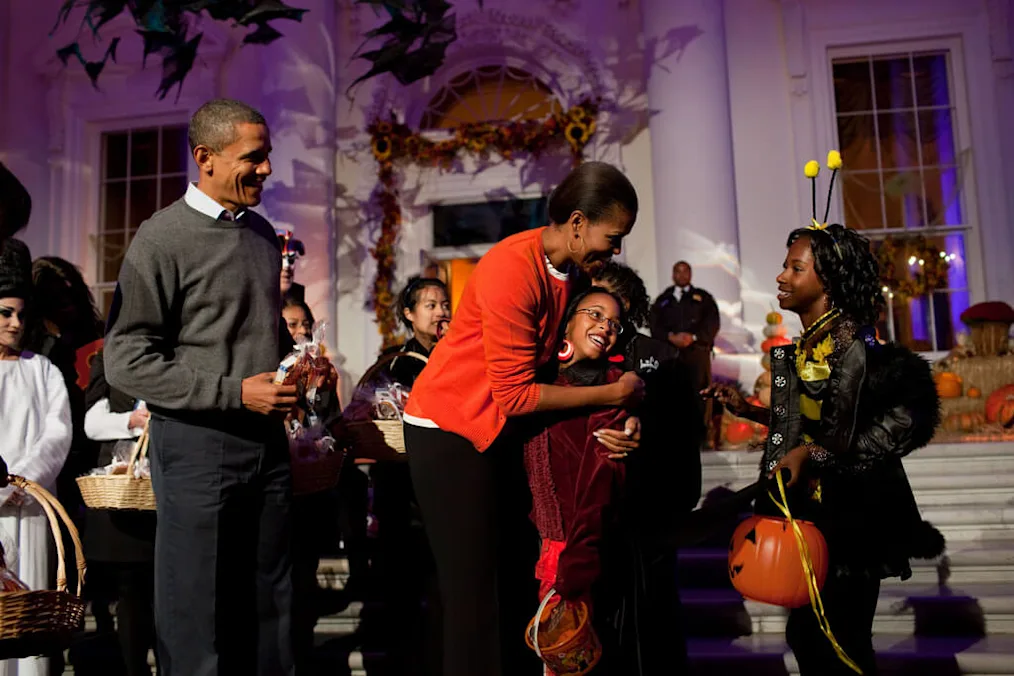
15/21

16/21
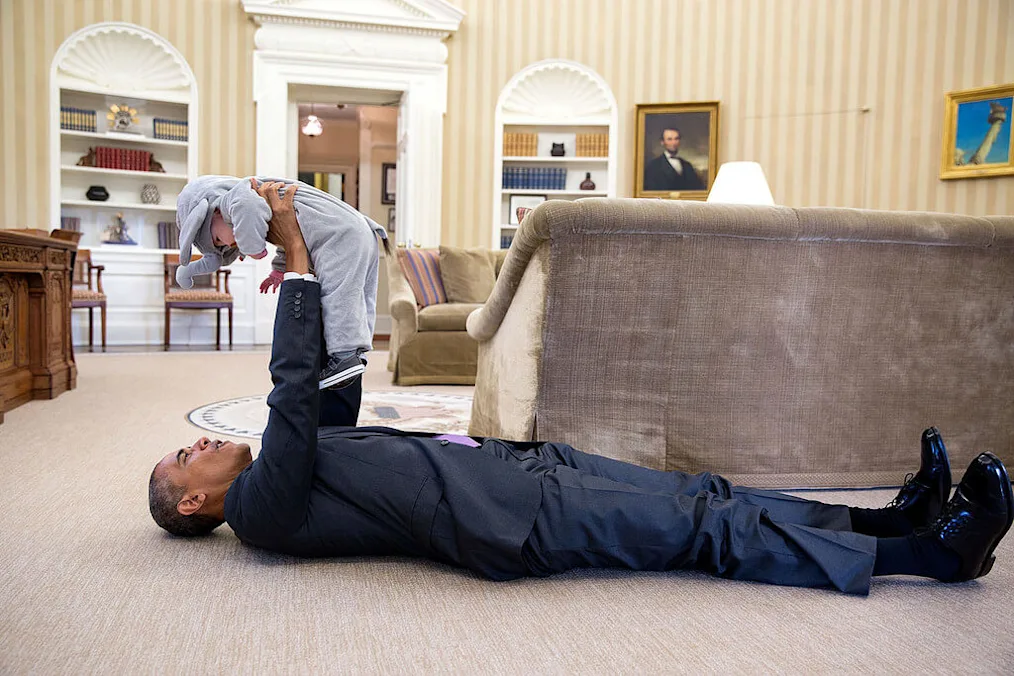
17/21

18/21

19/21
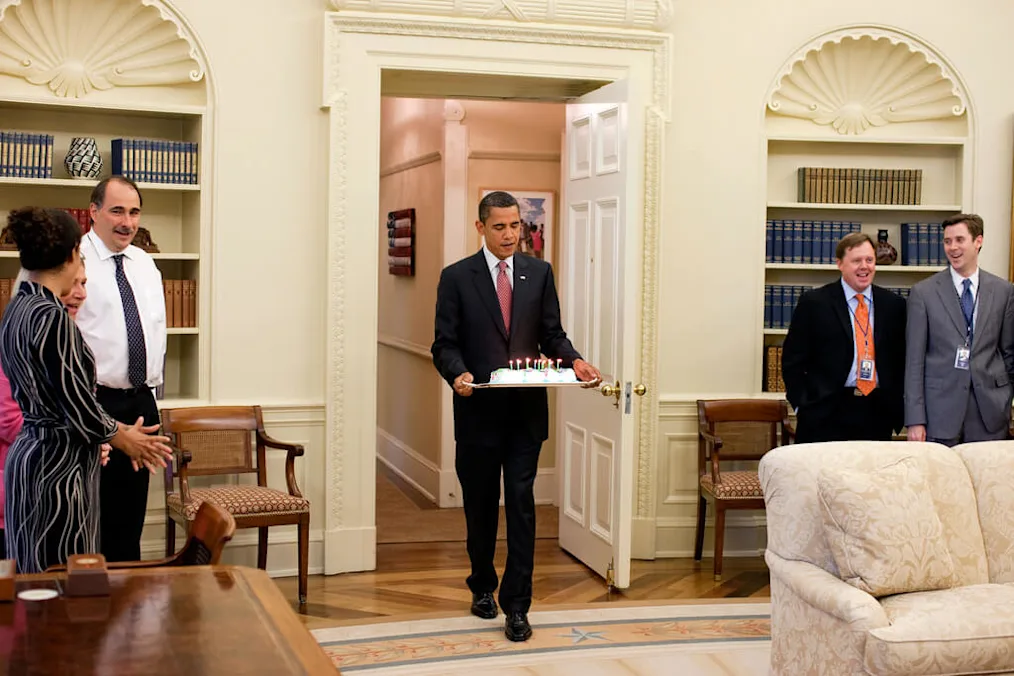
20/21
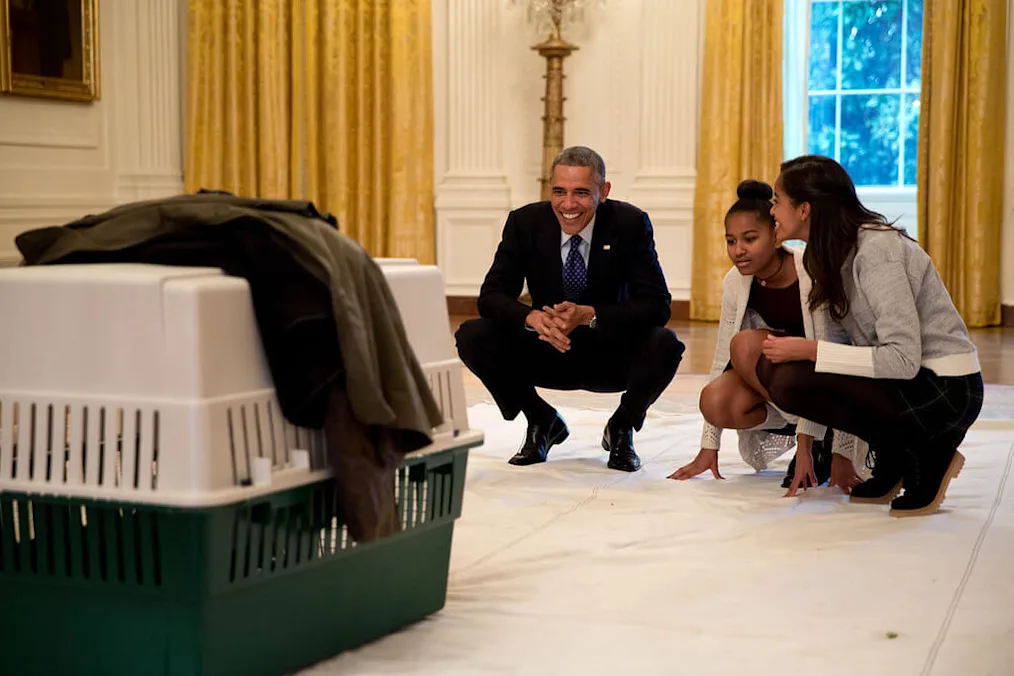
21/21

Bo Inspects the 2012 White House Holiday Decorations
January 10, 2017
President Obama Delivered His Farewell Address

Farewell Address to the American People
January 12, 2017
Surprised Joe Biden with the Presidential Medal of Freedom

President Obama Awards the Presidential Medal of Freedom to Vice President Biden

